Case Study Analysis of Zappos
VerifiedAdded on 2020/04/29
|21
|4906
|74
AI Summary
Contribute Materials
Your contribution can guide someone’s learning journey. Share your
documents today.
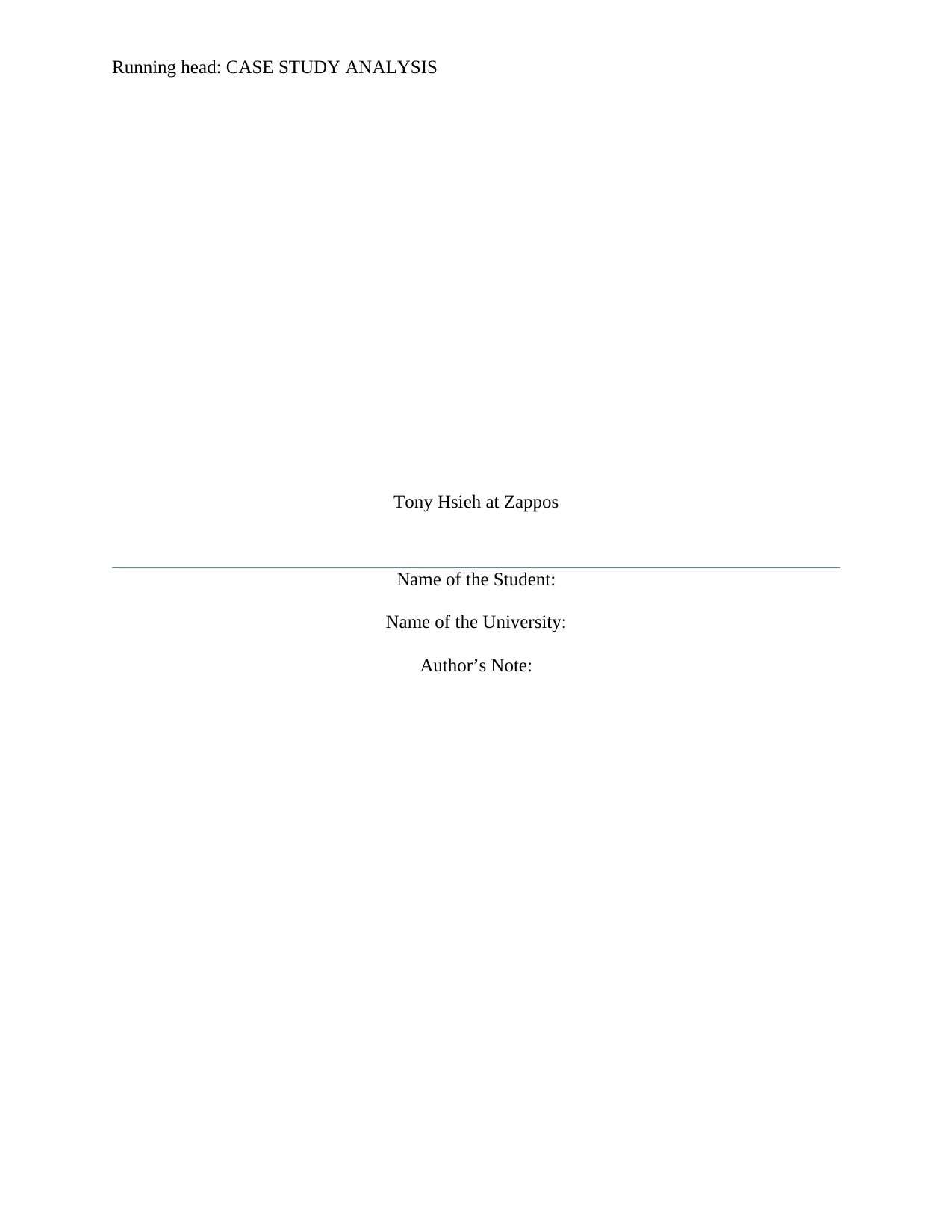
Running head: CASE STUDY ANALYSIS
Tony Hsieh at Zappos
Name of the Student:
Name of the University:
Author’s Note:
Tony Hsieh at Zappos
Name of the Student:
Name of the University:
Author’s Note:
Secure Best Marks with AI Grader
Need help grading? Try our AI Grader for instant feedback on your assignments.
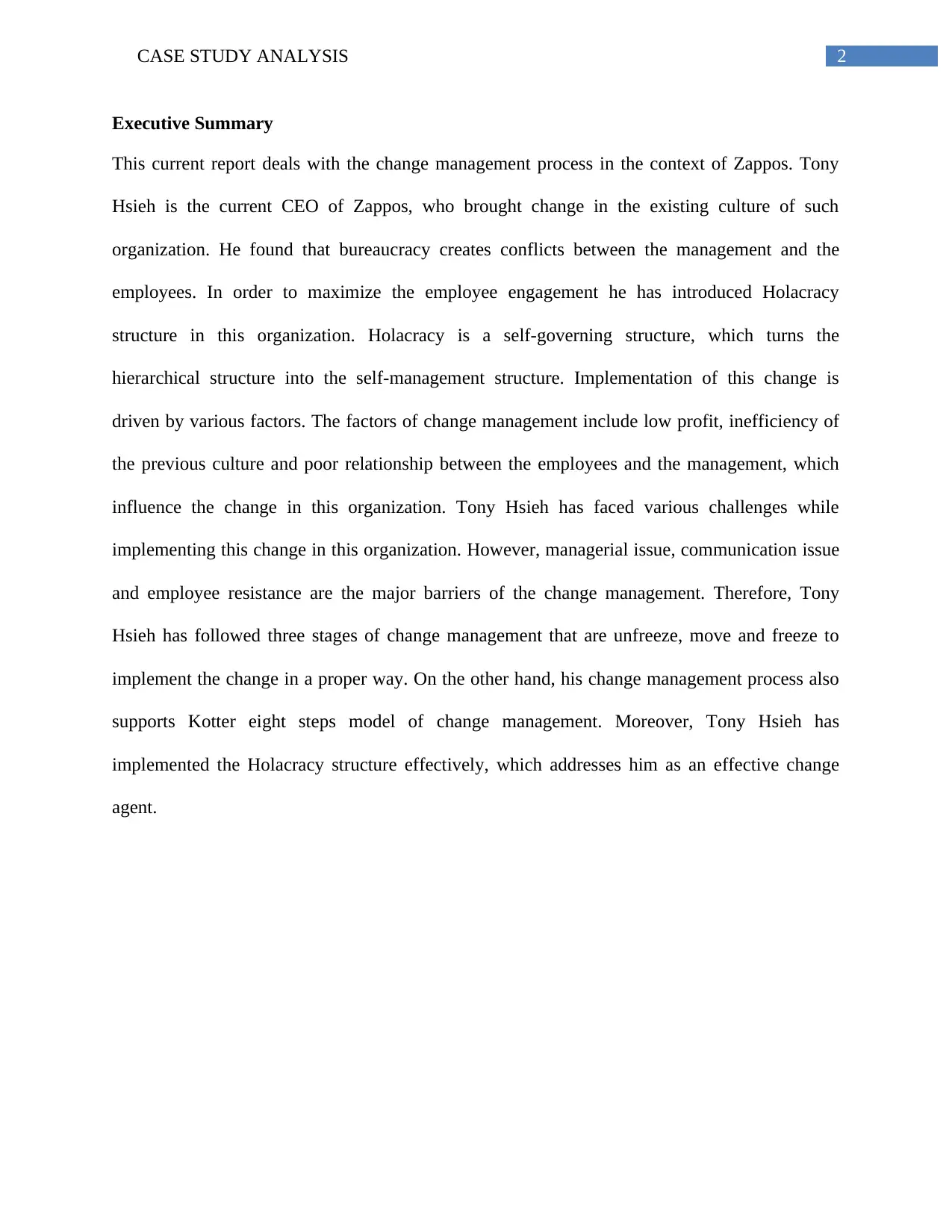
2CASE STUDY ANALYSIS
Executive Summary
This current report deals with the change management process in the context of Zappos. Tony
Hsieh is the current CEO of Zappos, who brought change in the existing culture of such
organization. He found that bureaucracy creates conflicts between the management and the
employees. In order to maximize the employee engagement he has introduced Holacracy
structure in this organization. Holacracy is a self-governing structure, which turns the
hierarchical structure into the self-management structure. Implementation of this change is
driven by various factors. The factors of change management include low profit, inefficiency of
the previous culture and poor relationship between the employees and the management, which
influence the change in this organization. Tony Hsieh has faced various challenges while
implementing this change in this organization. However, managerial issue, communication issue
and employee resistance are the major barriers of the change management. Therefore, Tony
Hsieh has followed three stages of change management that are unfreeze, move and freeze to
implement the change in a proper way. On the other hand, his change management process also
supports Kotter eight steps model of change management. Moreover, Tony Hsieh has
implemented the Holacracy structure effectively, which addresses him as an effective change
agent.
Executive Summary
This current report deals with the change management process in the context of Zappos. Tony
Hsieh is the current CEO of Zappos, who brought change in the existing culture of such
organization. He found that bureaucracy creates conflicts between the management and the
employees. In order to maximize the employee engagement he has introduced Holacracy
structure in this organization. Holacracy is a self-governing structure, which turns the
hierarchical structure into the self-management structure. Implementation of this change is
driven by various factors. The factors of change management include low profit, inefficiency of
the previous culture and poor relationship between the employees and the management, which
influence the change in this organization. Tony Hsieh has faced various challenges while
implementing this change in this organization. However, managerial issue, communication issue
and employee resistance are the major barriers of the change management. Therefore, Tony
Hsieh has followed three stages of change management that are unfreeze, move and freeze to
implement the change in a proper way. On the other hand, his change management process also
supports Kotter eight steps model of change management. Moreover, Tony Hsieh has
implemented the Holacracy structure effectively, which addresses him as an effective change
agent.
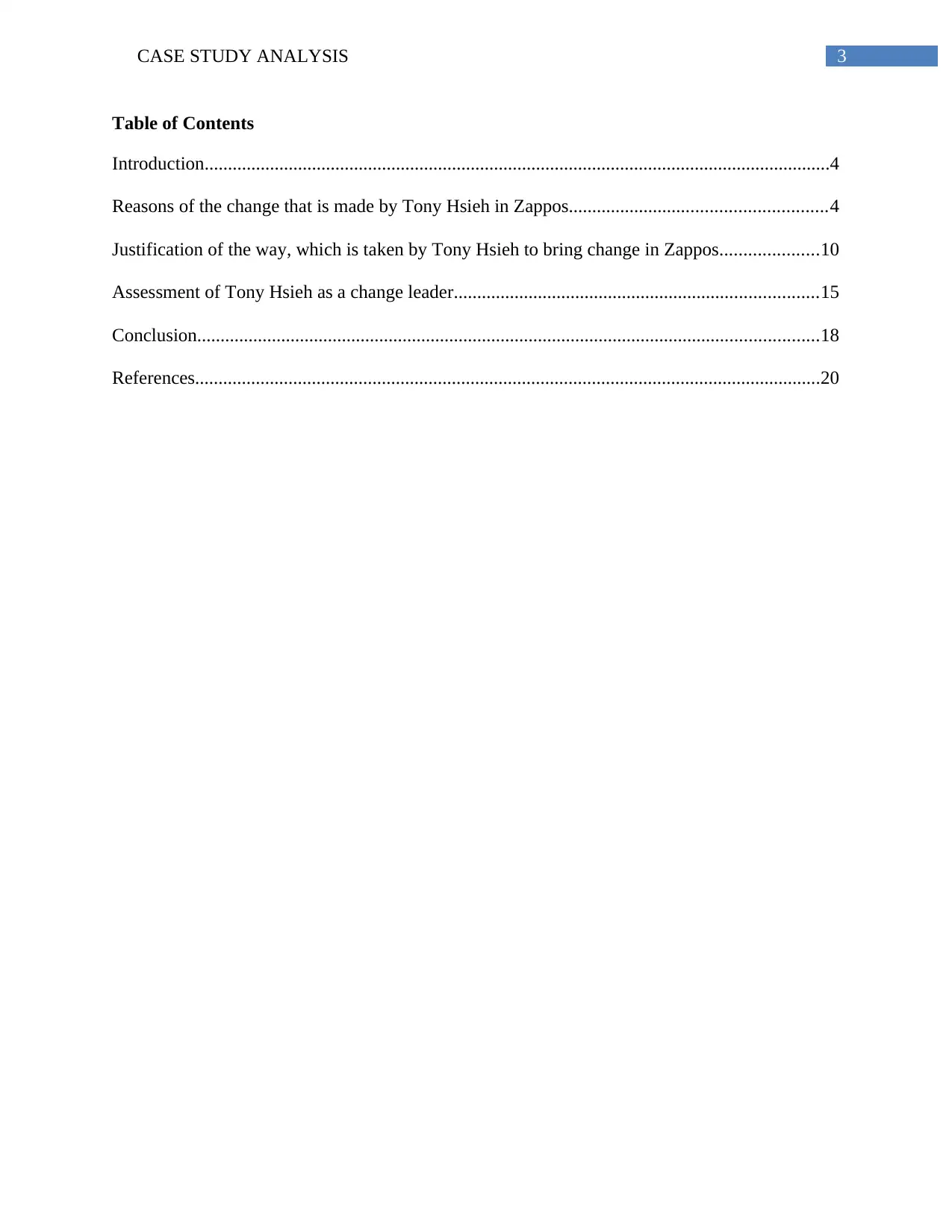
3CASE STUDY ANALYSIS
Table of Contents
Introduction......................................................................................................................................4
Reasons of the change that is made by Tony Hsieh in Zappos.......................................................4
Justification of the way, which is taken by Tony Hsieh to bring change in Zappos.....................10
Assessment of Tony Hsieh as a change leader..............................................................................15
Conclusion.....................................................................................................................................18
References......................................................................................................................................20
Table of Contents
Introduction......................................................................................................................................4
Reasons of the change that is made by Tony Hsieh in Zappos.......................................................4
Justification of the way, which is taken by Tony Hsieh to bring change in Zappos.....................10
Assessment of Tony Hsieh as a change leader..............................................................................15
Conclusion.....................................................................................................................................18
References......................................................................................................................................20
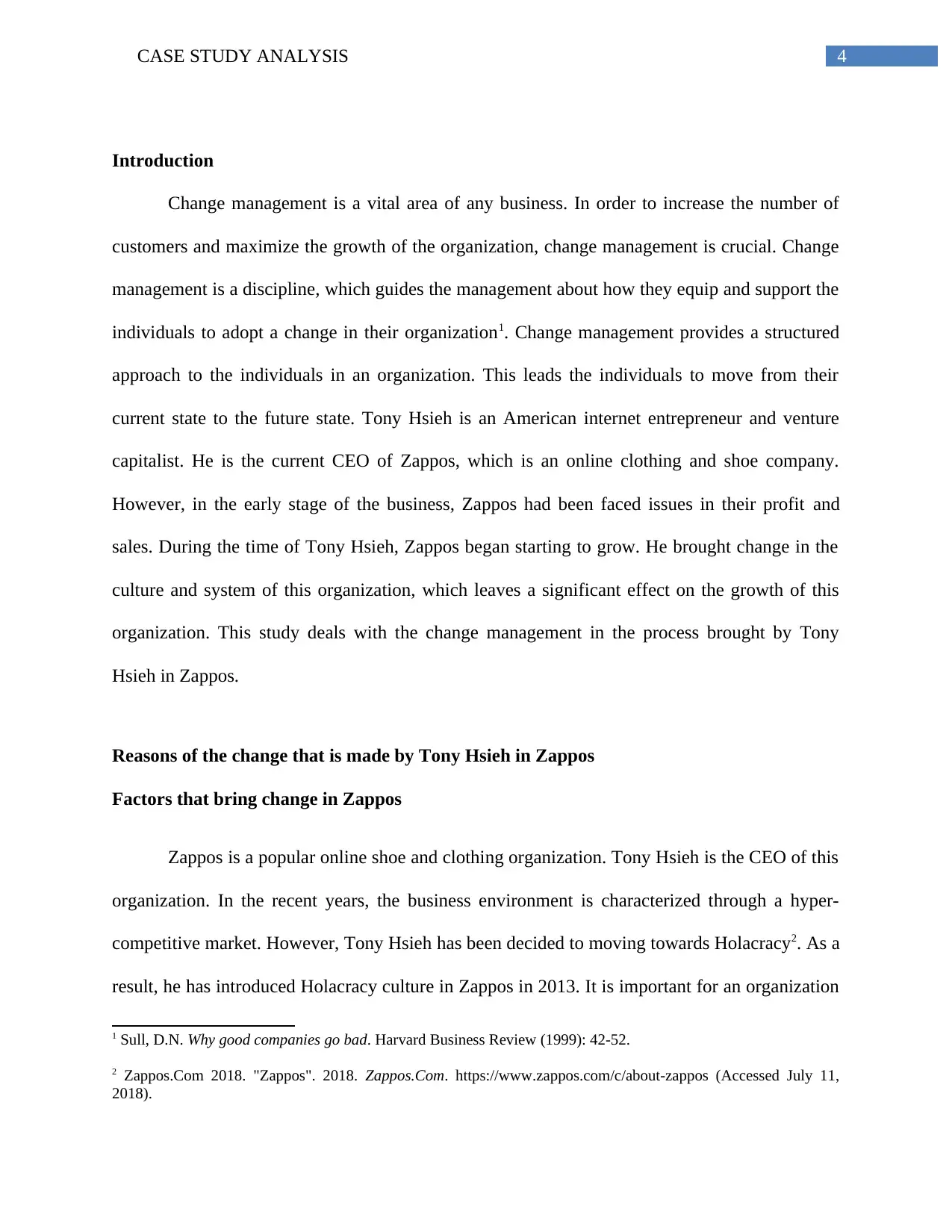
4CASE STUDY ANALYSIS
Introduction
Change management is a vital area of any business. In order to increase the number of
customers and maximize the growth of the organization, change management is crucial. Change
management is a discipline, which guides the management about how they equip and support the
individuals to adopt a change in their organization1. Change management provides a structured
approach to the individuals in an organization. This leads the individuals to move from their
current state to the future state. Tony Hsieh is an American internet entrepreneur and venture
capitalist. He is the current CEO of Zappos, which is an online clothing and shoe company.
However, in the early stage of the business, Zappos had been faced issues in their profit and
sales. During the time of Tony Hsieh, Zappos began starting to grow. He brought change in the
culture and system of this organization, which leaves a significant effect on the growth of this
organization. This study deals with the change management in the process brought by Tony
Hsieh in Zappos.
Reasons of the change that is made by Tony Hsieh in Zappos
Factors that bring change in Zappos
Zappos is a popular online shoe and clothing organization. Tony Hsieh is the CEO of this
organization. In the recent years, the business environment is characterized through a hyper-
competitive market. However, Tony Hsieh has been decided to moving towards Holacracy2. As a
result, he has introduced Holacracy culture in Zappos in 2013. It is important for an organization
1 Sull, D.N. Why good companies go bad. Harvard Business Review (1999): 42‐52.
2 Zappos.Com 2018. "Zappos". 2018. Zappos.Com. https://www.zappos.com/c/about-zappos (Accessed July 11,
2018).
Introduction
Change management is a vital area of any business. In order to increase the number of
customers and maximize the growth of the organization, change management is crucial. Change
management is a discipline, which guides the management about how they equip and support the
individuals to adopt a change in their organization1. Change management provides a structured
approach to the individuals in an organization. This leads the individuals to move from their
current state to the future state. Tony Hsieh is an American internet entrepreneur and venture
capitalist. He is the current CEO of Zappos, which is an online clothing and shoe company.
However, in the early stage of the business, Zappos had been faced issues in their profit and
sales. During the time of Tony Hsieh, Zappos began starting to grow. He brought change in the
culture and system of this organization, which leaves a significant effect on the growth of this
organization. This study deals with the change management in the process brought by Tony
Hsieh in Zappos.
Reasons of the change that is made by Tony Hsieh in Zappos
Factors that bring change in Zappos
Zappos is a popular online shoe and clothing organization. Tony Hsieh is the CEO of this
organization. In the recent years, the business environment is characterized through a hyper-
competitive market. However, Tony Hsieh has been decided to moving towards Holacracy2. As a
result, he has introduced Holacracy culture in Zappos in 2013. It is important for an organization
1 Sull, D.N. Why good companies go bad. Harvard Business Review (1999): 42‐52.
2 Zappos.Com 2018. "Zappos". 2018. Zappos.Com. https://www.zappos.com/c/about-zappos (Accessed July 11,
2018).
Secure Best Marks with AI Grader
Need help grading? Try our AI Grader for instant feedback on your assignments.
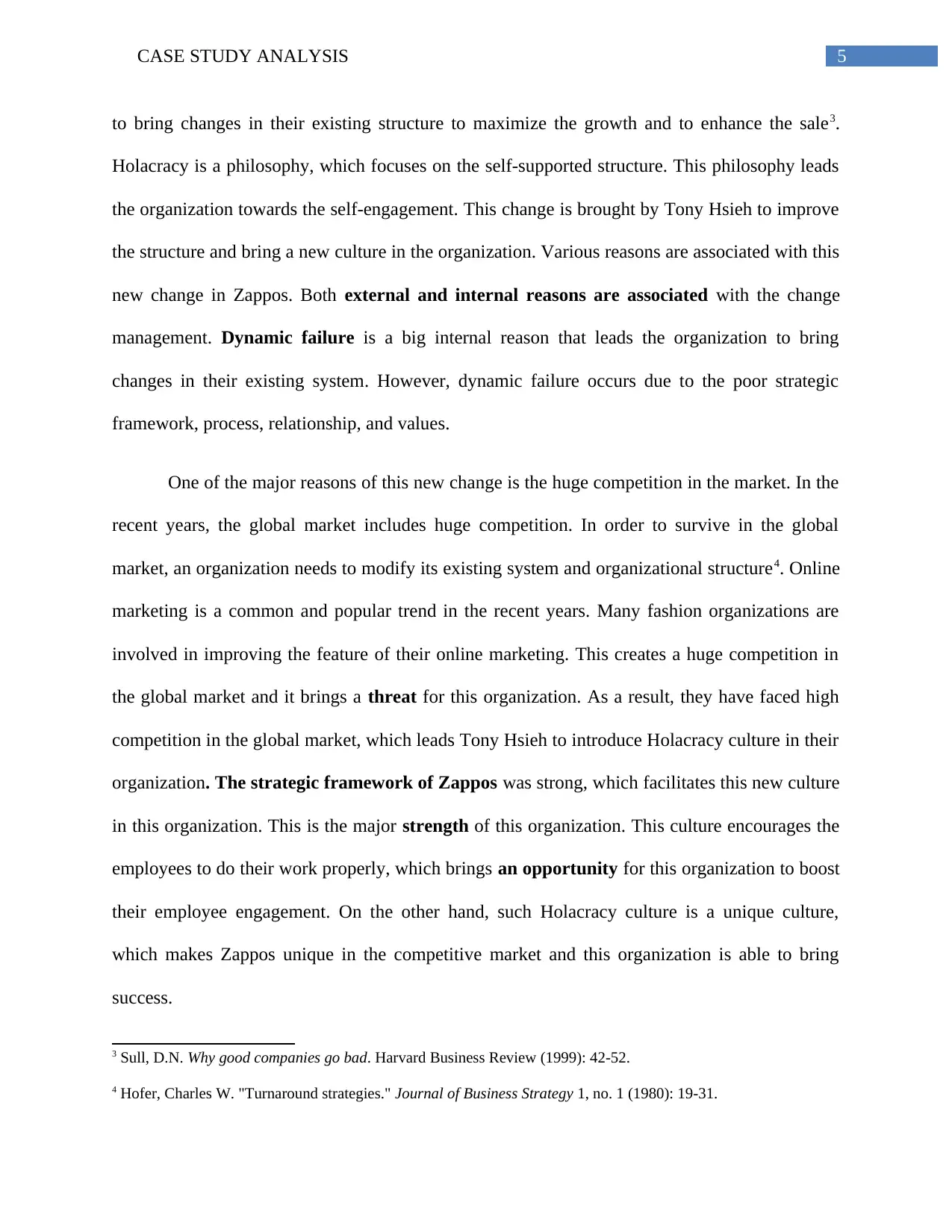
5CASE STUDY ANALYSIS
to bring changes in their existing structure to maximize the growth and to enhance the sale3.
Holacracy is a philosophy, which focuses on the self-supported structure. This philosophy leads
the organization towards the self-engagement. This change is brought by Tony Hsieh to improve
the structure and bring a new culture in the organization. Various reasons are associated with this
new change in Zappos. Both external and internal reasons are associated with the change
management. Dynamic failure is a big internal reason that leads the organization to bring
changes in their existing system. However, dynamic failure occurs due to the poor strategic
framework, process, relationship, and values.
One of the major reasons of this new change is the huge competition in the market. In the
recent years, the global market includes huge competition. In order to survive in the global
market, an organization needs to modify its existing system and organizational structure4. Online
marketing is a common and popular trend in the recent years. Many fashion organizations are
involved in improving the feature of their online marketing. This creates a huge competition in
the global market and it brings a threat for this organization. As a result, they have faced high
competition in the global market, which leads Tony Hsieh to introduce Holacracy culture in their
organization. The strategic framework of Zappos was strong, which facilitates this new culture
in this organization. This is the major strength of this organization. This culture encourages the
employees to do their work properly, which brings an opportunity for this organization to boost
their employee engagement. On the other hand, such Holacracy culture is a unique culture,
which makes Zappos unique in the competitive market and this organization is able to bring
success.
3 Sull, D.N. Why good companies go bad. Harvard Business Review (1999): 42‐52.
4 Hofer, Charles W. "Turnaround strategies." Journal of Business Strategy 1, no. 1 (1980): 19-31.
to bring changes in their existing structure to maximize the growth and to enhance the sale3.
Holacracy is a philosophy, which focuses on the self-supported structure. This philosophy leads
the organization towards the self-engagement. This change is brought by Tony Hsieh to improve
the structure and bring a new culture in the organization. Various reasons are associated with this
new change in Zappos. Both external and internal reasons are associated with the change
management. Dynamic failure is a big internal reason that leads the organization to bring
changes in their existing system. However, dynamic failure occurs due to the poor strategic
framework, process, relationship, and values.
One of the major reasons of this new change is the huge competition in the market. In the
recent years, the global market includes huge competition. In order to survive in the global
market, an organization needs to modify its existing system and organizational structure4. Online
marketing is a common and popular trend in the recent years. Many fashion organizations are
involved in improving the feature of their online marketing. This creates a huge competition in
the global market and it brings a threat for this organization. As a result, they have faced high
competition in the global market, which leads Tony Hsieh to introduce Holacracy culture in their
organization. The strategic framework of Zappos was strong, which facilitates this new culture
in this organization. This is the major strength of this organization. This culture encourages the
employees to do their work properly, which brings an opportunity for this organization to boost
their employee engagement. On the other hand, such Holacracy culture is a unique culture,
which makes Zappos unique in the competitive market and this organization is able to bring
success.
3 Sull, D.N. Why good companies go bad. Harvard Business Review (1999): 42‐52.
4 Hofer, Charles W. "Turnaround strategies." Journal of Business Strategy 1, no. 1 (1980): 19-31.
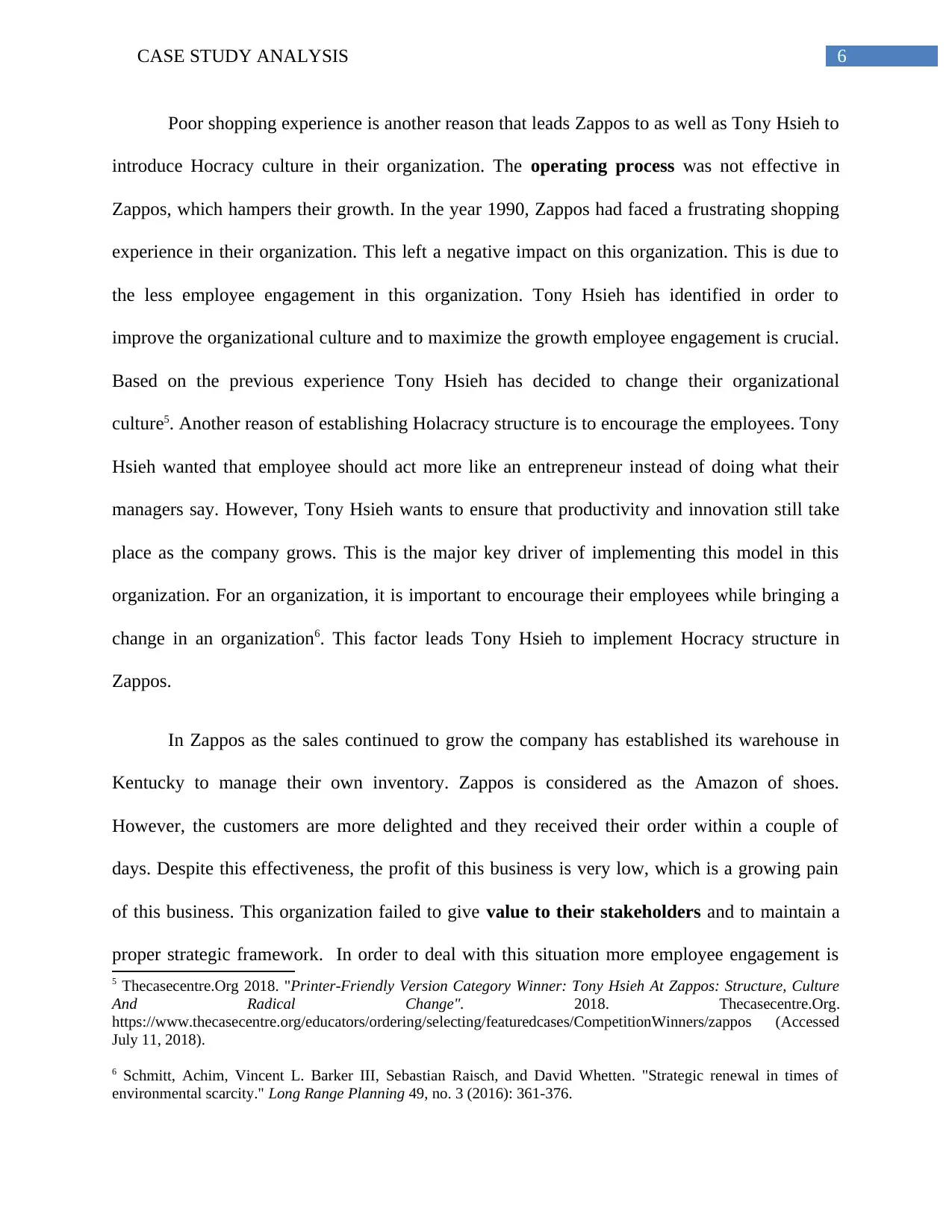
6CASE STUDY ANALYSIS
Poor shopping experience is another reason that leads Zappos to as well as Tony Hsieh to
introduce Hocracy culture in their organization. The operating process was not effective in
Zappos, which hampers their growth. In the year 1990, Zappos had faced a frustrating shopping
experience in their organization. This left a negative impact on this organization. This is due to
the less employee engagement in this organization. Tony Hsieh has identified in order to
improve the organizational culture and to maximize the growth employee engagement is crucial.
Based on the previous experience Tony Hsieh has decided to change their organizational
culture5. Another reason of establishing Holacracy structure is to encourage the employees. Tony
Hsieh wanted that employee should act more like an entrepreneur instead of doing what their
managers say. However, Tony Hsieh wants to ensure that productivity and innovation still take
place as the company grows. This is the major key driver of implementing this model in this
organization. For an organization, it is important to encourage their employees while bringing a
change in an organization6. This factor leads Tony Hsieh to implement Hocracy structure in
Zappos.
In Zappos as the sales continued to grow the company has established its warehouse in
Kentucky to manage their own inventory. Zappos is considered as the Amazon of shoes.
However, the customers are more delighted and they received their order within a couple of
days. Despite this effectiveness, the profit of this business is very low, which is a growing pain
of this business. This organization failed to give value to their stakeholders and to maintain a
proper strategic framework. In order to deal with this situation more employee engagement is
5 Thecasecentre.Org 2018. "Printer-Friendly Version Category Winner: Tony Hsieh At Zappos: Structure, Culture
And Radical Change". 2018. Thecasecentre.Org.
https://www.thecasecentre.org/educators/ordering/selecting/featuredcases/CompetitionWinners/zappos (Accessed
July 11, 2018).
6 Schmitt, Achim, Vincent L. Barker III, Sebastian Raisch, and David Whetten. "Strategic renewal in times of
environmental scarcity." Long Range Planning 49, no. 3 (2016): 361-376.
Poor shopping experience is another reason that leads Zappos to as well as Tony Hsieh to
introduce Hocracy culture in their organization. The operating process was not effective in
Zappos, which hampers their growth. In the year 1990, Zappos had faced a frustrating shopping
experience in their organization. This left a negative impact on this organization. This is due to
the less employee engagement in this organization. Tony Hsieh has identified in order to
improve the organizational culture and to maximize the growth employee engagement is crucial.
Based on the previous experience Tony Hsieh has decided to change their organizational
culture5. Another reason of establishing Holacracy structure is to encourage the employees. Tony
Hsieh wanted that employee should act more like an entrepreneur instead of doing what their
managers say. However, Tony Hsieh wants to ensure that productivity and innovation still take
place as the company grows. This is the major key driver of implementing this model in this
organization. For an organization, it is important to encourage their employees while bringing a
change in an organization6. This factor leads Tony Hsieh to implement Hocracy structure in
Zappos.
In Zappos as the sales continued to grow the company has established its warehouse in
Kentucky to manage their own inventory. Zappos is considered as the Amazon of shoes.
However, the customers are more delighted and they received their order within a couple of
days. Despite this effectiveness, the profit of this business is very low, which is a growing pain
of this business. This organization failed to give value to their stakeholders and to maintain a
proper strategic framework. In order to deal with this situation more employee engagement is
5 Thecasecentre.Org 2018. "Printer-Friendly Version Category Winner: Tony Hsieh At Zappos: Structure, Culture
And Radical Change". 2018. Thecasecentre.Org.
https://www.thecasecentre.org/educators/ordering/selecting/featuredcases/CompetitionWinners/zappos (Accessed
July 11, 2018).
6 Schmitt, Achim, Vincent L. Barker III, Sebastian Raisch, and David Whetten. "Strategic renewal in times of
environmental scarcity." Long Range Planning 49, no. 3 (2016): 361-376.
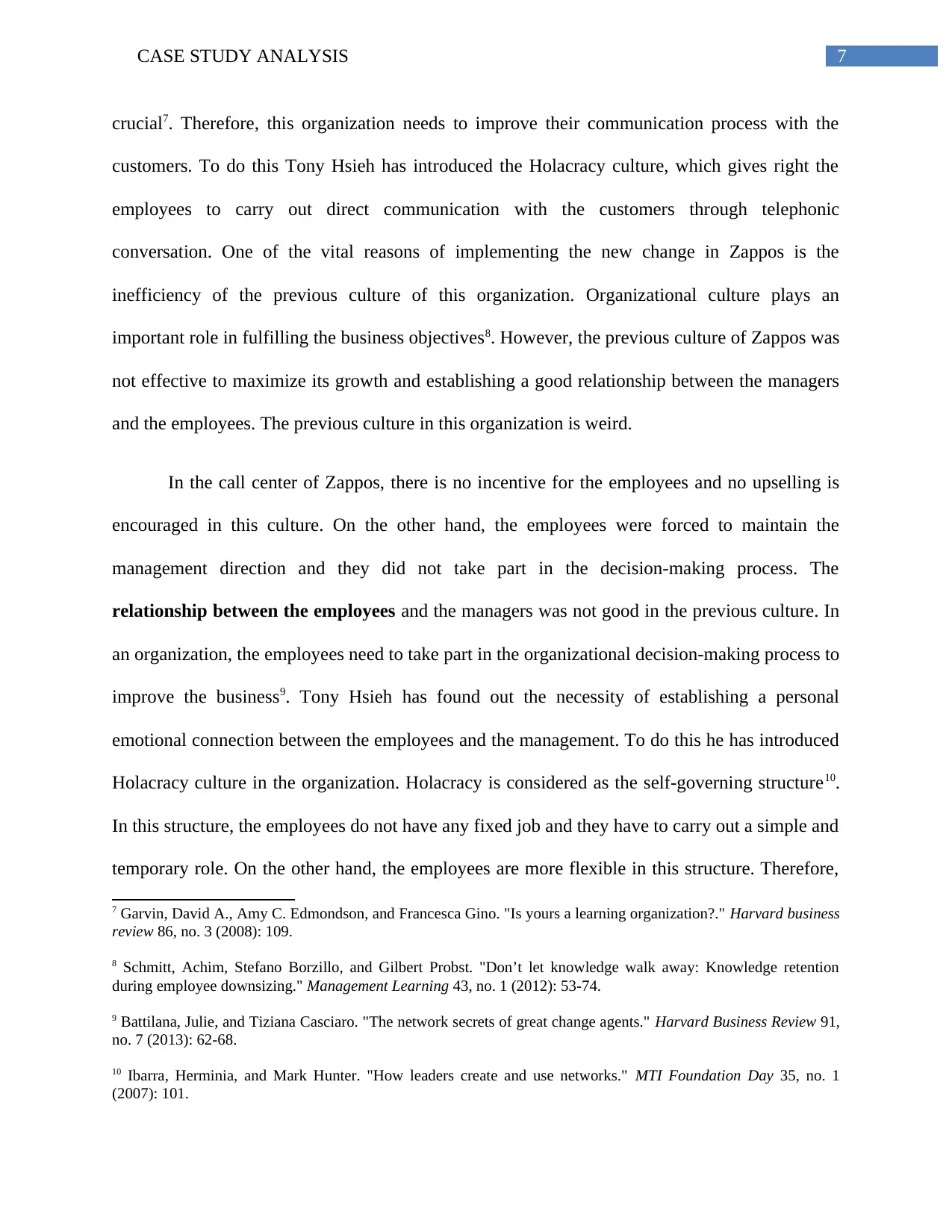
7CASE STUDY ANALYSIS
crucial7. Therefore, this organization needs to improve their communication process with the
customers. To do this Tony Hsieh has introduced the Holacracy culture, which gives right the
employees to carry out direct communication with the customers through telephonic
conversation. One of the vital reasons of implementing the new change in Zappos is the
inefficiency of the previous culture of this organization. Organizational culture plays an
important role in fulfilling the business objectives8. However, the previous culture of Zappos was
not effective to maximize its growth and establishing a good relationship between the managers
and the employees. The previous culture in this organization is weird.
In the call center of Zappos, there is no incentive for the employees and no upselling is
encouraged in this culture. On the other hand, the employees were forced to maintain the
management direction and they did not take part in the decision-making process. The
relationship between the employees and the managers was not good in the previous culture. In
an organization, the employees need to take part in the organizational decision-making process to
improve the business9. Tony Hsieh has found out the necessity of establishing a personal
emotional connection between the employees and the management. To do this he has introduced
Holacracy culture in the organization. Holacracy is considered as the self-governing structure10.
In this structure, the employees do not have any fixed job and they have to carry out a simple and
temporary role. On the other hand, the employees are more flexible in this structure. Therefore,
7 Garvin, David A., Amy C. Edmondson, and Francesca Gino. "Is yours a learning organization?." Harvard business
review 86, no. 3 (2008): 109.
8 Schmitt, Achim, Stefano Borzillo, and Gilbert Probst. "Don’t let knowledge walk away: Knowledge retention
during employee downsizing." Management Learning 43, no. 1 (2012): 53-74.
9 Battilana, Julie, and Tiziana Casciaro. "The network secrets of great change agents." Harvard Business Review 91,
no. 7 (2013): 62-68.
10 Ibarra, Herminia, and Mark Hunter. "How leaders create and use networks." MTI Foundation Day 35, no. 1
(2007): 101.
crucial7. Therefore, this organization needs to improve their communication process with the
customers. To do this Tony Hsieh has introduced the Holacracy culture, which gives right the
employees to carry out direct communication with the customers through telephonic
conversation. One of the vital reasons of implementing the new change in Zappos is the
inefficiency of the previous culture of this organization. Organizational culture plays an
important role in fulfilling the business objectives8. However, the previous culture of Zappos was
not effective to maximize its growth and establishing a good relationship between the managers
and the employees. The previous culture in this organization is weird.
In the call center of Zappos, there is no incentive for the employees and no upselling is
encouraged in this culture. On the other hand, the employees were forced to maintain the
management direction and they did not take part in the decision-making process. The
relationship between the employees and the managers was not good in the previous culture. In
an organization, the employees need to take part in the organizational decision-making process to
improve the business9. Tony Hsieh has found out the necessity of establishing a personal
emotional connection between the employees and the management. To do this he has introduced
Holacracy culture in the organization. Holacracy is considered as the self-governing structure10.
In this structure, the employees do not have any fixed job and they have to carry out a simple and
temporary role. On the other hand, the employees are more flexible in this structure. Therefore,
7 Garvin, David A., Amy C. Edmondson, and Francesca Gino. "Is yours a learning organization?." Harvard business
review 86, no. 3 (2008): 109.
8 Schmitt, Achim, Stefano Borzillo, and Gilbert Probst. "Don’t let knowledge walk away: Knowledge retention
during employee downsizing." Management Learning 43, no. 1 (2012): 53-74.
9 Battilana, Julie, and Tiziana Casciaro. "The network secrets of great change agents." Harvard Business Review 91,
no. 7 (2013): 62-68.
10 Ibarra, Herminia, and Mark Hunter. "How leaders create and use networks." MTI Foundation Day 35, no. 1
(2007): 101.
Paraphrase This Document
Need a fresh take? Get an instant paraphrase of this document with our AI Paraphraser
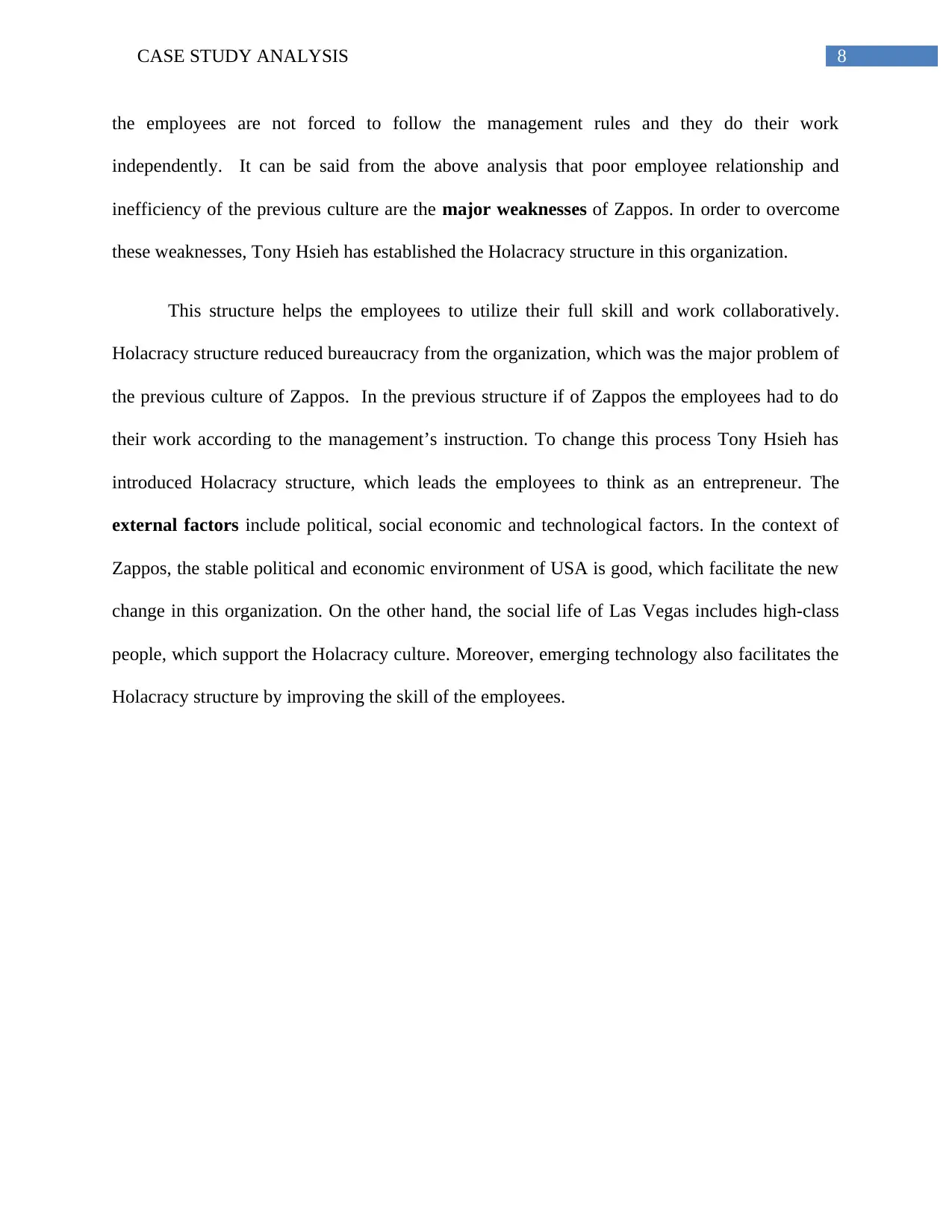
8CASE STUDY ANALYSIS
the employees are not forced to follow the management rules and they do their work
independently. It can be said from the above analysis that poor employee relationship and
inefficiency of the previous culture are the major weaknesses of Zappos. In order to overcome
these weaknesses, Tony Hsieh has established the Holacracy structure in this organization.
This structure helps the employees to utilize their full skill and work collaboratively.
Holacracy structure reduced bureaucracy from the organization, which was the major problem of
the previous culture of Zappos. In the previous structure if of Zappos the employees had to do
their work according to the management’s instruction. To change this process Tony Hsieh has
introduced Holacracy structure, which leads the employees to think as an entrepreneur. The
external factors include political, social economic and technological factors. In the context of
Zappos, the stable political and economic environment of USA is good, which facilitate the new
change in this organization. On the other hand, the social life of Las Vegas includes high-class
people, which support the Holacracy culture. Moreover, emerging technology also facilitates the
Holacracy structure by improving the skill of the employees.
the employees are not forced to follow the management rules and they do their work
independently. It can be said from the above analysis that poor employee relationship and
inefficiency of the previous culture are the major weaknesses of Zappos. In order to overcome
these weaknesses, Tony Hsieh has established the Holacracy structure in this organization.
This structure helps the employees to utilize their full skill and work collaboratively.
Holacracy structure reduced bureaucracy from the organization, which was the major problem of
the previous culture of Zappos. In the previous structure if of Zappos the employees had to do
their work according to the management’s instruction. To change this process Tony Hsieh has
introduced Holacracy structure, which leads the employees to think as an entrepreneur. The
external factors include political, social economic and technological factors. In the context of
Zappos, the stable political and economic environment of USA is good, which facilitate the new
change in this organization. On the other hand, the social life of Las Vegas includes high-class
people, which support the Holacracy culture. Moreover, emerging technology also facilitates the
Holacracy structure by improving the skill of the employees.
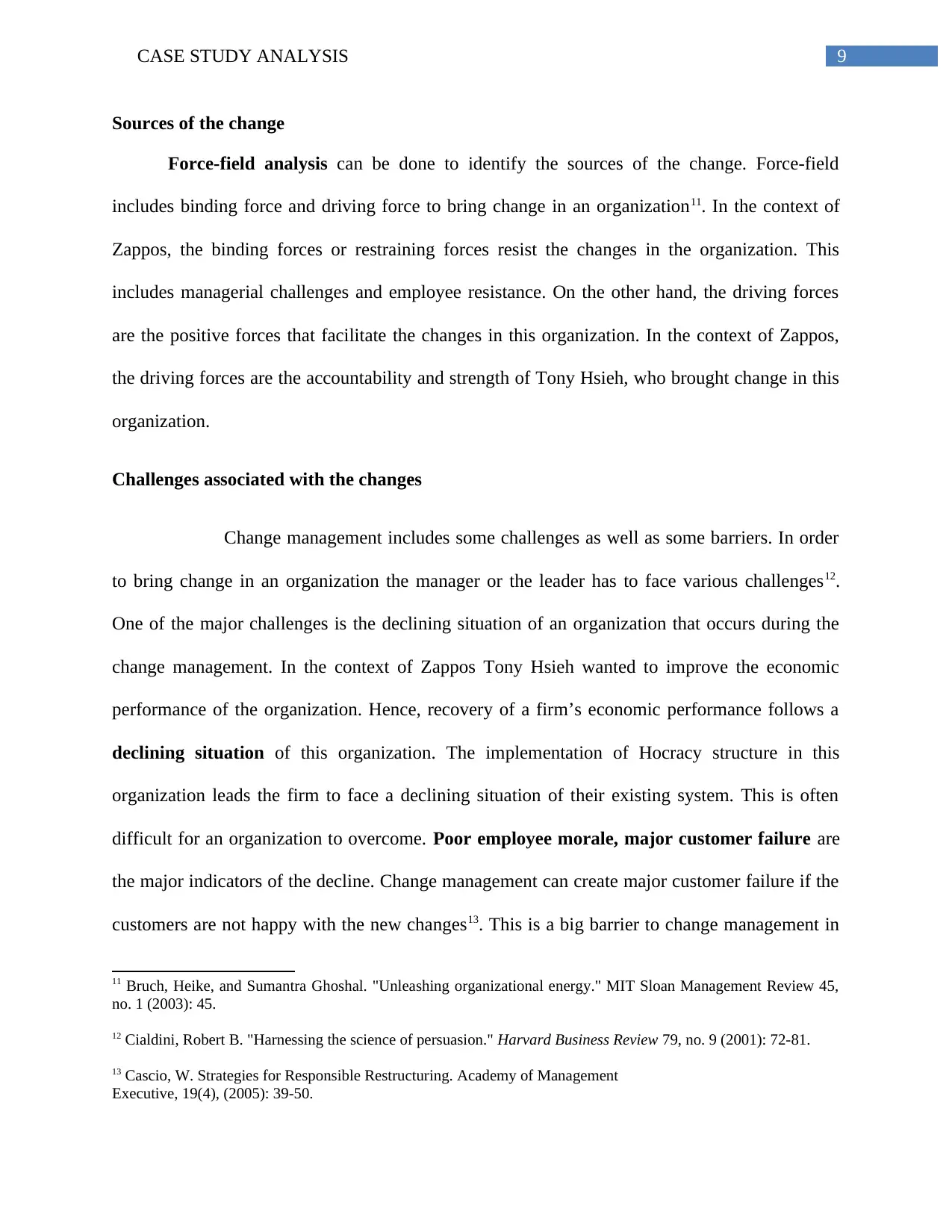
9CASE STUDY ANALYSIS
Sources of the change
Force-field analysis can be done to identify the sources of the change. Force-field
includes binding force and driving force to bring change in an organization11. In the context of
Zappos, the binding forces or restraining forces resist the changes in the organization. This
includes managerial challenges and employee resistance. On the other hand, the driving forces
are the positive forces that facilitate the changes in this organization. In the context of Zappos,
the driving forces are the accountability and strength of Tony Hsieh, who brought change in this
organization.
Challenges associated with the changes
Change management includes some challenges as well as some barriers. In order
to bring change in an organization the manager or the leader has to face various challenges12.
One of the major challenges is the declining situation of an organization that occurs during the
change management. In the context of Zappos Tony Hsieh wanted to improve the economic
performance of the organization. Hence, recovery of a firm’s economic performance follows a
declining situation of this organization. The implementation of Hocracy structure in this
organization leads the firm to face a declining situation of their existing system. This is often
difficult for an organization to overcome. Poor employee morale, major customer failure are
the major indicators of the decline. Change management can create major customer failure if the
customers are not happy with the new changes13. This is a big barrier to change management in
11 Bruch, Heike, and Sumantra Ghoshal. "Unleashing organizational energy." MIT Sloan Management Review 45,
no. 1 (2003): 45.
12 Cialdini, Robert B. "Harnessing the science of persuasion." Harvard Business Review 79, no. 9 (2001): 72-81.
13 Cascio, W. Strategies for Responsible Restructuring. Academy of Management
Executive, 19(4), (2005): 39‐50.
Sources of the change
Force-field analysis can be done to identify the sources of the change. Force-field
includes binding force and driving force to bring change in an organization11. In the context of
Zappos, the binding forces or restraining forces resist the changes in the organization. This
includes managerial challenges and employee resistance. On the other hand, the driving forces
are the positive forces that facilitate the changes in this organization. In the context of Zappos,
the driving forces are the accountability and strength of Tony Hsieh, who brought change in this
organization.
Challenges associated with the changes
Change management includes some challenges as well as some barriers. In order
to bring change in an organization the manager or the leader has to face various challenges12.
One of the major challenges is the declining situation of an organization that occurs during the
change management. In the context of Zappos Tony Hsieh wanted to improve the economic
performance of the organization. Hence, recovery of a firm’s economic performance follows a
declining situation of this organization. The implementation of Hocracy structure in this
organization leads the firm to face a declining situation of their existing system. This is often
difficult for an organization to overcome. Poor employee morale, major customer failure are
the major indicators of the decline. Change management can create major customer failure if the
customers are not happy with the new changes13. This is a big barrier to change management in
11 Bruch, Heike, and Sumantra Ghoshal. "Unleashing organizational energy." MIT Sloan Management Review 45,
no. 1 (2003): 45.
12 Cialdini, Robert B. "Harnessing the science of persuasion." Harvard Business Review 79, no. 9 (2001): 72-81.
13 Cascio, W. Strategies for Responsible Restructuring. Academy of Management
Executive, 19(4), (2005): 39‐50.
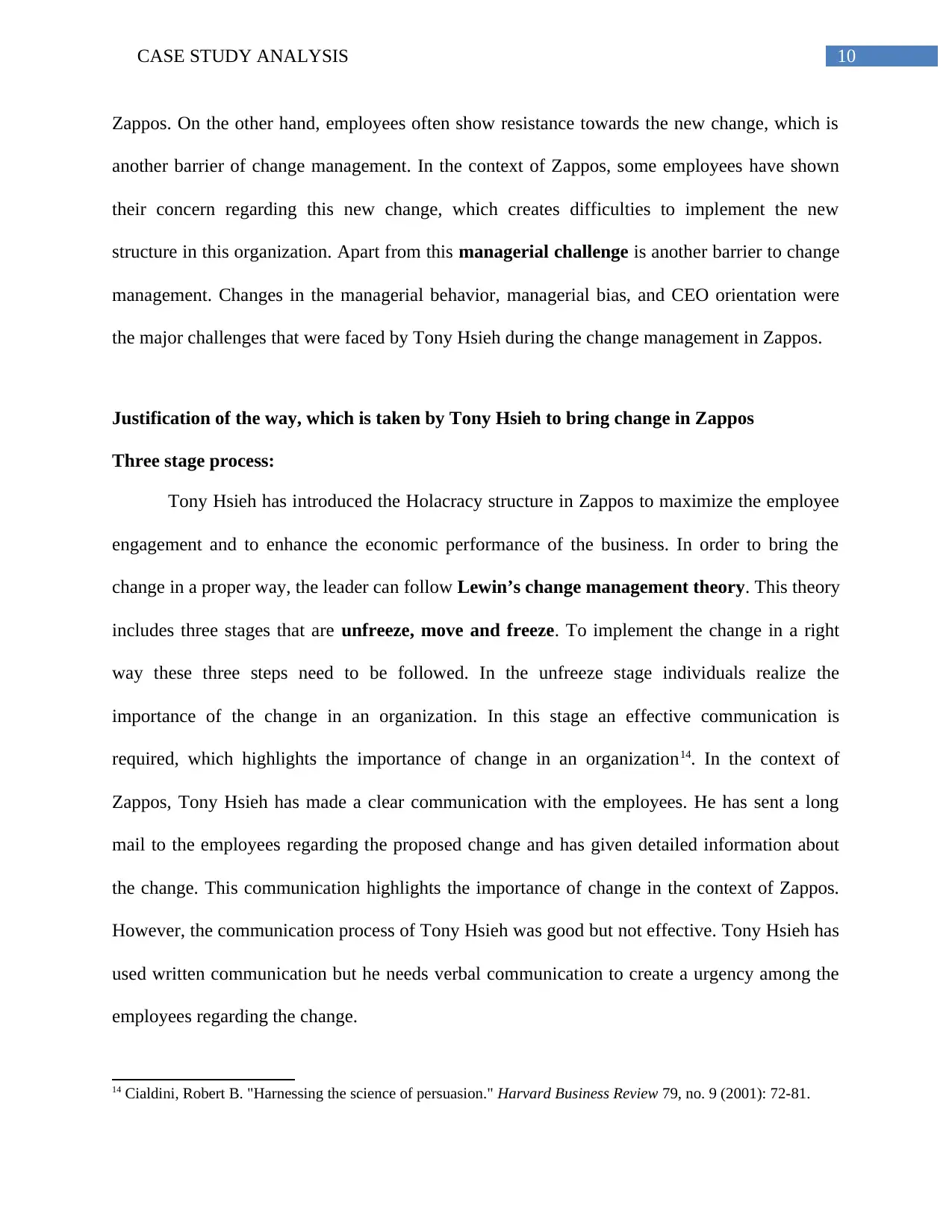
10CASE STUDY ANALYSIS
Zappos. On the other hand, employees often show resistance towards the new change, which is
another barrier of change management. In the context of Zappos, some employees have shown
their concern regarding this new change, which creates difficulties to implement the new
structure in this organization. Apart from this managerial challenge is another barrier to change
management. Changes in the managerial behavior, managerial bias, and CEO orientation were
the major challenges that were faced by Tony Hsieh during the change management in Zappos.
Justification of the way, which is taken by Tony Hsieh to bring change in Zappos
Three stage process:
Tony Hsieh has introduced the Holacracy structure in Zappos to maximize the employee
engagement and to enhance the economic performance of the business. In order to bring the
change in a proper way, the leader can follow Lewin’s change management theory. This theory
includes three stages that are unfreeze, move and freeze. To implement the change in a right
way these three steps need to be followed. In the unfreeze stage individuals realize the
importance of the change in an organization. In this stage an effective communication is
required, which highlights the importance of change in an organization14. In the context of
Zappos, Tony Hsieh has made a clear communication with the employees. He has sent a long
mail to the employees regarding the proposed change and has given detailed information about
the change. This communication highlights the importance of change in the context of Zappos.
However, the communication process of Tony Hsieh was good but not effective. Tony Hsieh has
used written communication but he needs verbal communication to create a urgency among the
employees regarding the change.
14 Cialdini, Robert B. "Harnessing the science of persuasion." Harvard Business Review 79, no. 9 (2001): 72-81.
Zappos. On the other hand, employees often show resistance towards the new change, which is
another barrier of change management. In the context of Zappos, some employees have shown
their concern regarding this new change, which creates difficulties to implement the new
structure in this organization. Apart from this managerial challenge is another barrier to change
management. Changes in the managerial behavior, managerial bias, and CEO orientation were
the major challenges that were faced by Tony Hsieh during the change management in Zappos.
Justification of the way, which is taken by Tony Hsieh to bring change in Zappos
Three stage process:
Tony Hsieh has introduced the Holacracy structure in Zappos to maximize the employee
engagement and to enhance the economic performance of the business. In order to bring the
change in a proper way, the leader can follow Lewin’s change management theory. This theory
includes three stages that are unfreeze, move and freeze. To implement the change in a right
way these three steps need to be followed. In the unfreeze stage individuals realize the
importance of the change in an organization. In this stage an effective communication is
required, which highlights the importance of change in an organization14. In the context of
Zappos, Tony Hsieh has made a clear communication with the employees. He has sent a long
mail to the employees regarding the proposed change and has given detailed information about
the change. This communication highlights the importance of change in the context of Zappos.
However, the communication process of Tony Hsieh was good but not effective. Tony Hsieh has
used written communication but he needs verbal communication to create a urgency among the
employees regarding the change.
14 Cialdini, Robert B. "Harnessing the science of persuasion." Harvard Business Review 79, no. 9 (2001): 72-81.
Secure Best Marks with AI Grader
Need help grading? Try our AI Grader for instant feedback on your assignments.
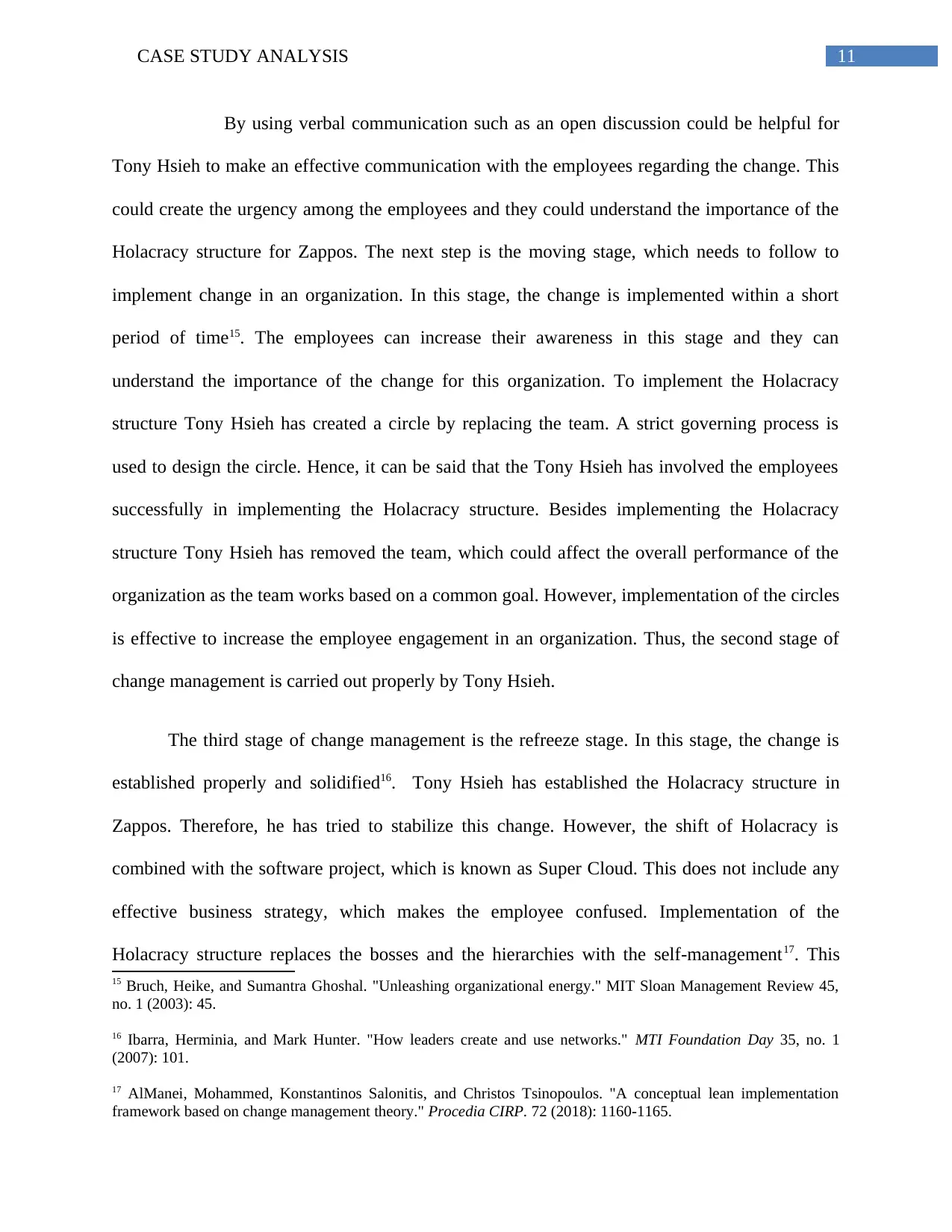
11CASE STUDY ANALYSIS
By using verbal communication such as an open discussion could be helpful for
Tony Hsieh to make an effective communication with the employees regarding the change. This
could create the urgency among the employees and they could understand the importance of the
Holacracy structure for Zappos. The next step is the moving stage, which needs to follow to
implement change in an organization. In this stage, the change is implemented within a short
period of time15. The employees can increase their awareness in this stage and they can
understand the importance of the change for this organization. To implement the Holacracy
structure Tony Hsieh has created a circle by replacing the team. A strict governing process is
used to design the circle. Hence, it can be said that the Tony Hsieh has involved the employees
successfully in implementing the Holacracy structure. Besides implementing the Holacracy
structure Tony Hsieh has removed the team, which could affect the overall performance of the
organization as the team works based on a common goal. However, implementation of the circles
is effective to increase the employee engagement in an organization. Thus, the second stage of
change management is carried out properly by Tony Hsieh.
The third stage of change management is the refreeze stage. In this stage, the change is
established properly and solidified16. Tony Hsieh has established the Holacracy structure in
Zappos. Therefore, he has tried to stabilize this change. However, the shift of Holacracy is
combined with the software project, which is known as Super Cloud. This does not include any
effective business strategy, which makes the employee confused. Implementation of the
Holacracy structure replaces the bosses and the hierarchies with the self-management17. This
15 Bruch, Heike, and Sumantra Ghoshal. "Unleashing organizational energy." MIT Sloan Management Review 45,
no. 1 (2003): 45.
16 Ibarra, Herminia, and Mark Hunter. "How leaders create and use networks." MTI Foundation Day 35, no. 1
(2007): 101.
17 AlManei, Mohammed, Konstantinos Salonitis, and Christos Tsinopoulos. "A conceptual lean implementation
framework based on change management theory." Procedia CIRP. 72 (2018): 1160-1165.
By using verbal communication such as an open discussion could be helpful for
Tony Hsieh to make an effective communication with the employees regarding the change. This
could create the urgency among the employees and they could understand the importance of the
Holacracy structure for Zappos. The next step is the moving stage, which needs to follow to
implement change in an organization. In this stage, the change is implemented within a short
period of time15. The employees can increase their awareness in this stage and they can
understand the importance of the change for this organization. To implement the Holacracy
structure Tony Hsieh has created a circle by replacing the team. A strict governing process is
used to design the circle. Hence, it can be said that the Tony Hsieh has involved the employees
successfully in implementing the Holacracy structure. Besides implementing the Holacracy
structure Tony Hsieh has removed the team, which could affect the overall performance of the
organization as the team works based on a common goal. However, implementation of the circles
is effective to increase the employee engagement in an organization. Thus, the second stage of
change management is carried out properly by Tony Hsieh.
The third stage of change management is the refreeze stage. In this stage, the change is
established properly and solidified16. Tony Hsieh has established the Holacracy structure in
Zappos. Therefore, he has tried to stabilize this change. However, the shift of Holacracy is
combined with the software project, which is known as Super Cloud. This does not include any
effective business strategy, which makes the employee confused. Implementation of the
Holacracy structure replaces the bosses and the hierarchies with the self-management17. This
15 Bruch, Heike, and Sumantra Ghoshal. "Unleashing organizational energy." MIT Sloan Management Review 45,
no. 1 (2003): 45.
16 Ibarra, Herminia, and Mark Hunter. "How leaders create and use networks." MTI Foundation Day 35, no. 1
(2007): 101.
17 AlManei, Mohammed, Konstantinos Salonitis, and Christos Tsinopoulos. "A conceptual lean implementation
framework based on change management theory." Procedia CIRP. 72 (2018): 1160-1165.
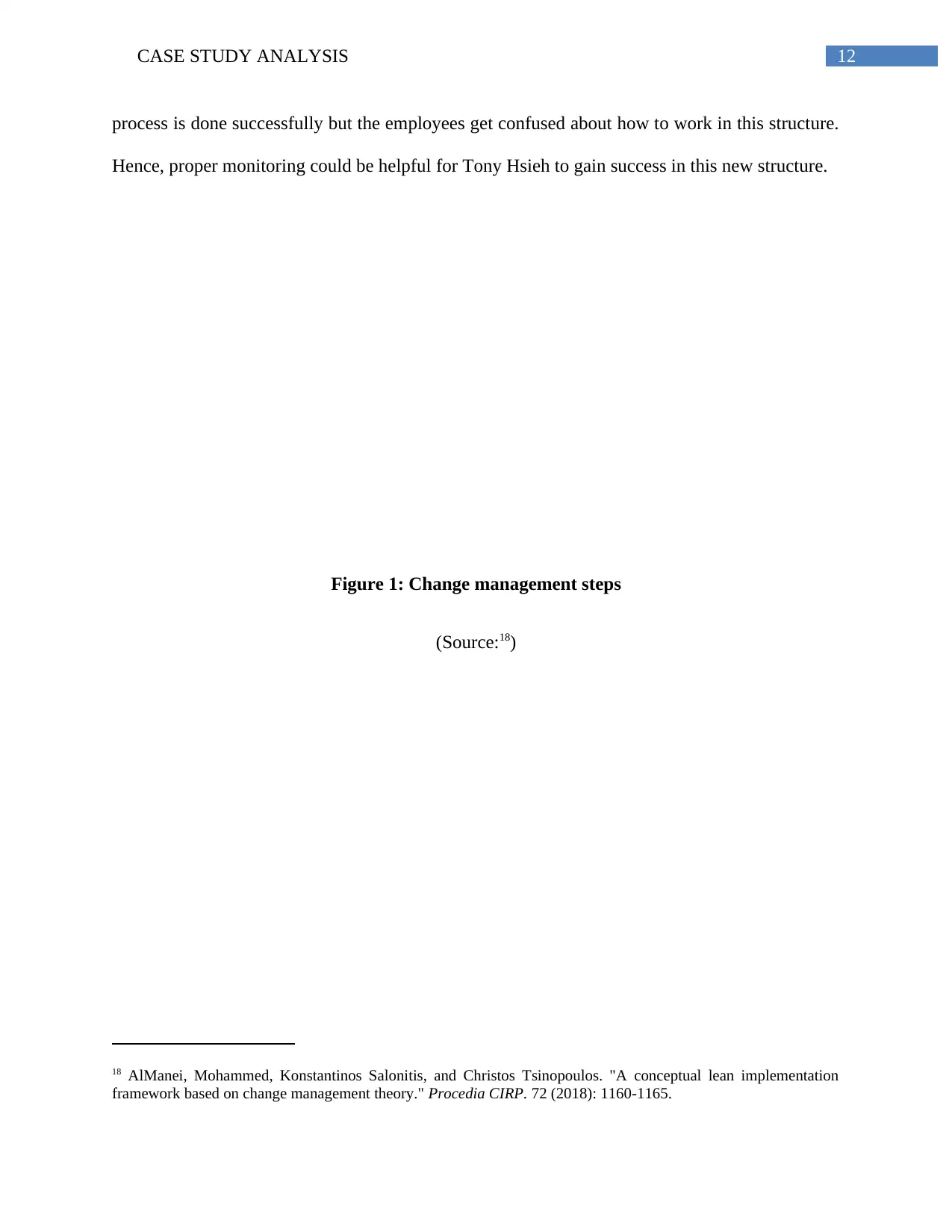
12CASE STUDY ANALYSIS
process is done successfully but the employees get confused about how to work in this structure.
Hence, proper monitoring could be helpful for Tony Hsieh to gain success in this new structure.
Figure 1: Change management steps
(Source:18)
18 AlManei, Mohammed, Konstantinos Salonitis, and Christos Tsinopoulos. "A conceptual lean implementation
framework based on change management theory." Procedia CIRP. 72 (2018): 1160-1165.
MoveFreezeUnfreeze
process is done successfully but the employees get confused about how to work in this structure.
Hence, proper monitoring could be helpful for Tony Hsieh to gain success in this new structure.
Figure 1: Change management steps
(Source:18)
18 AlManei, Mohammed, Konstantinos Salonitis, and Christos Tsinopoulos. "A conceptual lean implementation
framework based on change management theory." Procedia CIRP. 72 (2018): 1160-1165.
MoveFreezeUnfreeze
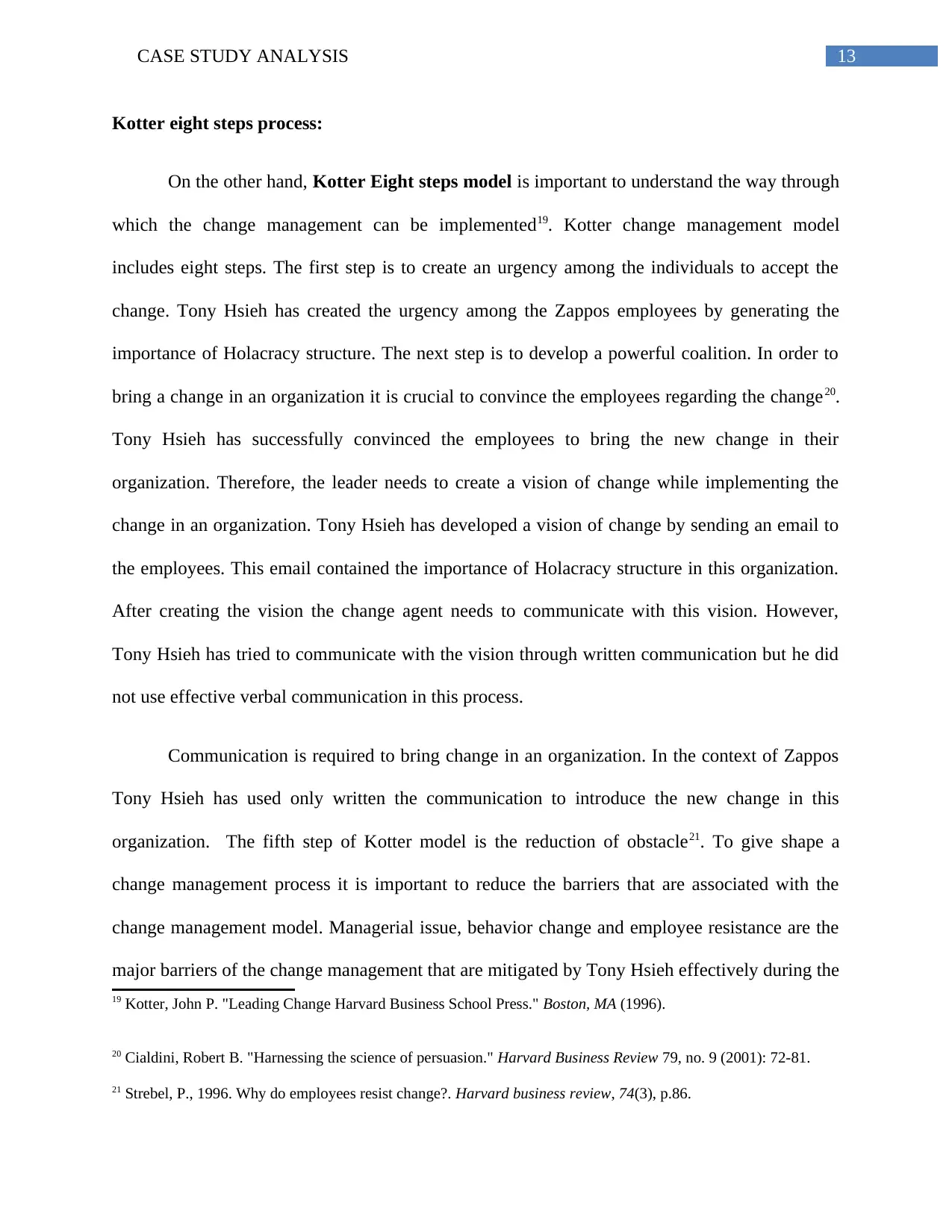
13CASE STUDY ANALYSIS
Kotter eight steps process:
On the other hand, Kotter Eight steps model is important to understand the way through
which the change management can be implemented19. Kotter change management model
includes eight steps. The first step is to create an urgency among the individuals to accept the
change. Tony Hsieh has created the urgency among the Zappos employees by generating the
importance of Holacracy structure. The next step is to develop a powerful coalition. In order to
bring a change in an organization it is crucial to convince the employees regarding the change20.
Tony Hsieh has successfully convinced the employees to bring the new change in their
organization. Therefore, the leader needs to create a vision of change while implementing the
change in an organization. Tony Hsieh has developed a vision of change by sending an email to
the employees. This email contained the importance of Holacracy structure in this organization.
After creating the vision the change agent needs to communicate with this vision. However,
Tony Hsieh has tried to communicate with the vision through written communication but he did
not use effective verbal communication in this process.
Communication is required to bring change in an organization. In the context of Zappos
Tony Hsieh has used only written the communication to introduce the new change in this
organization. The fifth step of Kotter model is the reduction of obstacle21. To give shape a
change management process it is important to reduce the barriers that are associated with the
change management model. Managerial issue, behavior change and employee resistance are the
major barriers of the change management that are mitigated by Tony Hsieh effectively during the
19 Kotter, John P. "Leading Change Harvard Business School Press." Boston, MA (1996).
20 Cialdini, Robert B. "Harnessing the science of persuasion." Harvard Business Review 79, no. 9 (2001): 72-81.
21 Strebel, P., 1996. Why do employees resist change?. Harvard business review, 74(3), p.86.
Kotter eight steps process:
On the other hand, Kotter Eight steps model is important to understand the way through
which the change management can be implemented19. Kotter change management model
includes eight steps. The first step is to create an urgency among the individuals to accept the
change. Tony Hsieh has created the urgency among the Zappos employees by generating the
importance of Holacracy structure. The next step is to develop a powerful coalition. In order to
bring a change in an organization it is crucial to convince the employees regarding the change20.
Tony Hsieh has successfully convinced the employees to bring the new change in their
organization. Therefore, the leader needs to create a vision of change while implementing the
change in an organization. Tony Hsieh has developed a vision of change by sending an email to
the employees. This email contained the importance of Holacracy structure in this organization.
After creating the vision the change agent needs to communicate with this vision. However,
Tony Hsieh has tried to communicate with the vision through written communication but he did
not use effective verbal communication in this process.
Communication is required to bring change in an organization. In the context of Zappos
Tony Hsieh has used only written the communication to introduce the new change in this
organization. The fifth step of Kotter model is the reduction of obstacle21. To give shape a
change management process it is important to reduce the barriers that are associated with the
change management model. Managerial issue, behavior change and employee resistance are the
major barriers of the change management that are mitigated by Tony Hsieh effectively during the
19 Kotter, John P. "Leading Change Harvard Business School Press." Boston, MA (1996).
20 Cialdini, Robert B. "Harnessing the science of persuasion." Harvard Business Review 79, no. 9 (2001): 72-81.
21 Strebel, P., 1996. Why do employees resist change?. Harvard business review, 74(3), p.86.
Paraphrase This Document
Need a fresh take? Get an instant paraphrase of this document with our AI Paraphraser
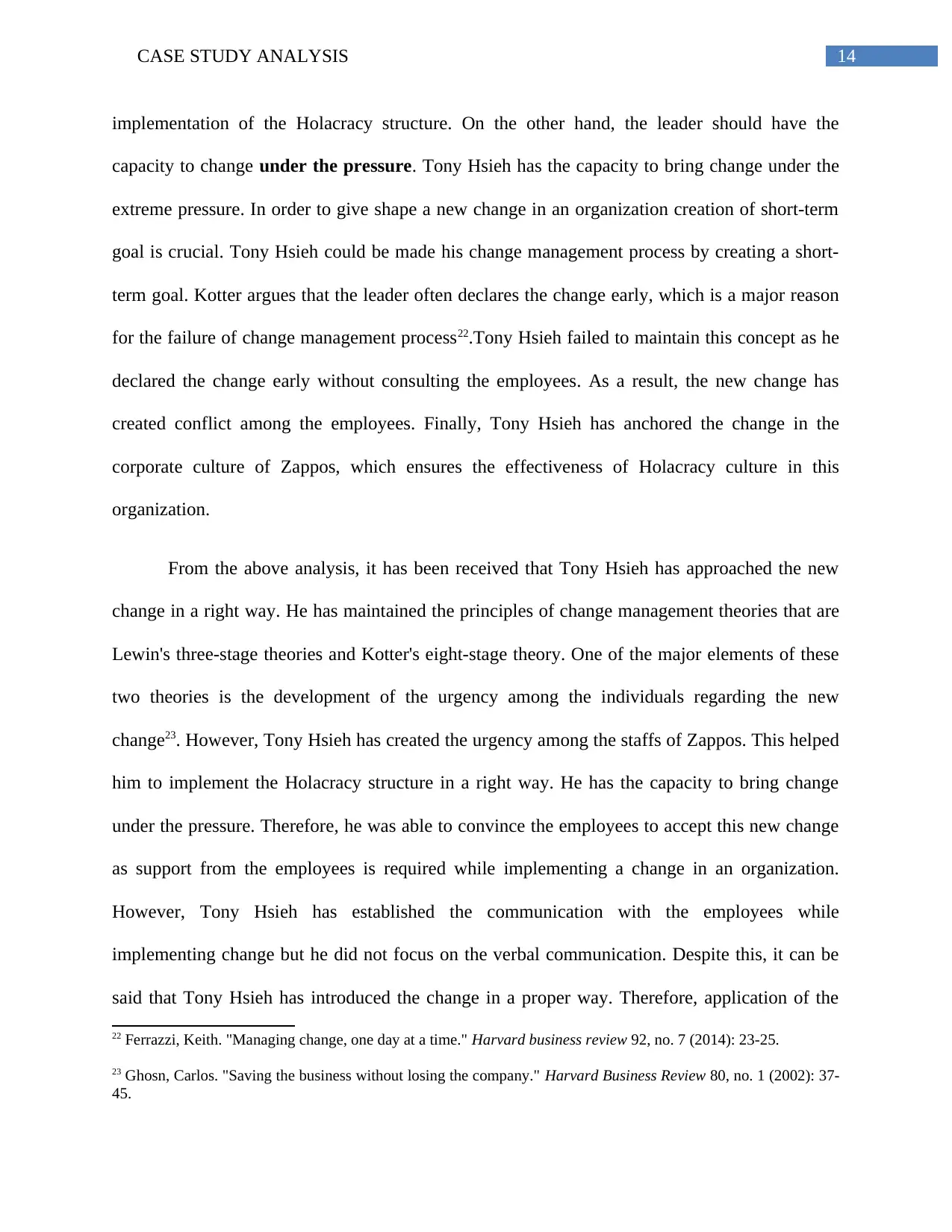
14CASE STUDY ANALYSIS
implementation of the Holacracy structure. On the other hand, the leader should have the
capacity to change under the pressure. Tony Hsieh has the capacity to bring change under the
extreme pressure. In order to give shape a new change in an organization creation of short-term
goal is crucial. Tony Hsieh could be made his change management process by creating a short-
term goal. Kotter argues that the leader often declares the change early, which is a major reason
for the failure of change management process22.Tony Hsieh failed to maintain this concept as he
declared the change early without consulting the employees. As a result, the new change has
created conflict among the employees. Finally, Tony Hsieh has anchored the change in the
corporate culture of Zappos, which ensures the effectiveness of Holacracy culture in this
organization.
From the above analysis, it has been received that Tony Hsieh has approached the new
change in a right way. He has maintained the principles of change management theories that are
Lewin's three-stage theories and Kotter's eight-stage theory. One of the major elements of these
two theories is the development of the urgency among the individuals regarding the new
change23. However, Tony Hsieh has created the urgency among the staffs of Zappos. This helped
him to implement the Holacracy structure in a right way. He has the capacity to bring change
under the pressure. Therefore, he was able to convince the employees to accept this new change
as support from the employees is required while implementing a change in an organization.
However, Tony Hsieh has established the communication with the employees while
implementing change but he did not focus on the verbal communication. Despite this, it can be
said that Tony Hsieh has introduced the change in a proper way. Therefore, application of the
22 Ferrazzi, Keith. "Managing change, one day at a time." Harvard business review 92, no. 7 (2014): 23-25.
23 Ghosn, Carlos. "Saving the business without losing the company." Harvard Business Review 80, no. 1 (2002): 37-
45.
implementation of the Holacracy structure. On the other hand, the leader should have the
capacity to change under the pressure. Tony Hsieh has the capacity to bring change under the
extreme pressure. In order to give shape a new change in an organization creation of short-term
goal is crucial. Tony Hsieh could be made his change management process by creating a short-
term goal. Kotter argues that the leader often declares the change early, which is a major reason
for the failure of change management process22.Tony Hsieh failed to maintain this concept as he
declared the change early without consulting the employees. As a result, the new change has
created conflict among the employees. Finally, Tony Hsieh has anchored the change in the
corporate culture of Zappos, which ensures the effectiveness of Holacracy culture in this
organization.
From the above analysis, it has been received that Tony Hsieh has approached the new
change in a right way. He has maintained the principles of change management theories that are
Lewin's three-stage theories and Kotter's eight-stage theory. One of the major elements of these
two theories is the development of the urgency among the individuals regarding the new
change23. However, Tony Hsieh has created the urgency among the staffs of Zappos. This helped
him to implement the Holacracy structure in a right way. He has the capacity to bring change
under the pressure. Therefore, he was able to convince the employees to accept this new change
as support from the employees is required while implementing a change in an organization.
However, Tony Hsieh has established the communication with the employees while
implementing change but he did not focus on the verbal communication. Despite this, it can be
said that Tony Hsieh has introduced the change in a proper way. Therefore, application of the
22 Ferrazzi, Keith. "Managing change, one day at a time." Harvard business review 92, no. 7 (2014): 23-25.
23 Ghosn, Carlos. "Saving the business without losing the company." Harvard Business Review 80, no. 1 (2002): 37-
45.
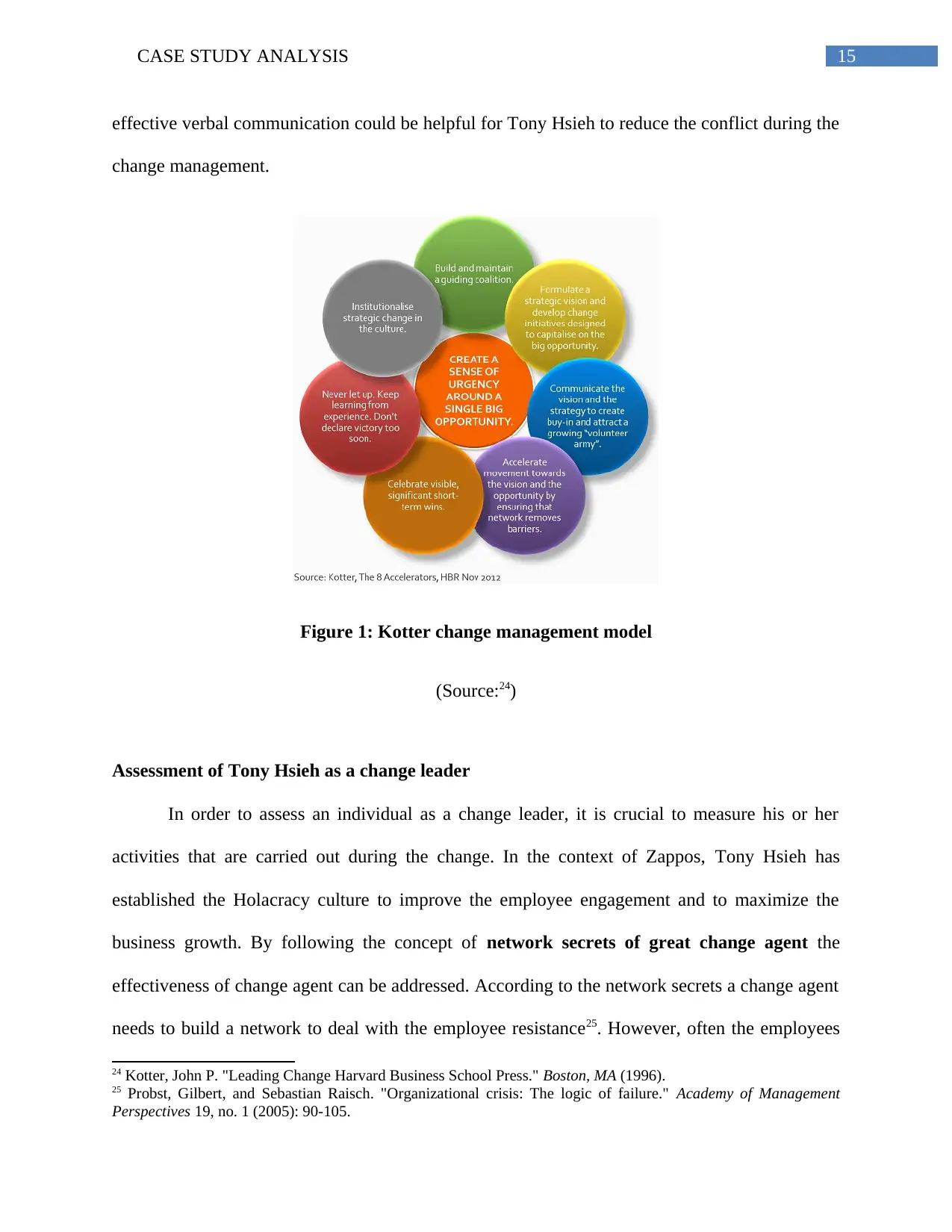
15CASE STUDY ANALYSIS
effective verbal communication could be helpful for Tony Hsieh to reduce the conflict during the
change management.
Figure 1: Kotter change management model
(Source:24)
Assessment of Tony Hsieh as a change leader
In order to assess an individual as a change leader, it is crucial to measure his or her
activities that are carried out during the change. In the context of Zappos, Tony Hsieh has
established the Holacracy culture to improve the employee engagement and to maximize the
business growth. By following the concept of network secrets of great change agent the
effectiveness of change agent can be addressed. According to the network secrets a change agent
needs to build a network to deal with the employee resistance25. However, often the employees
24 Kotter, John P. "Leading Change Harvard Business School Press." Boston, MA (1996).
25 Probst, Gilbert, and Sebastian Raisch. "Organizational crisis: The logic of failure." Academy of Management
Perspectives 19, no. 1 (2005): 90-105.
effective verbal communication could be helpful for Tony Hsieh to reduce the conflict during the
change management.
Figure 1: Kotter change management model
(Source:24)
Assessment of Tony Hsieh as a change leader
In order to assess an individual as a change leader, it is crucial to measure his or her
activities that are carried out during the change. In the context of Zappos, Tony Hsieh has
established the Holacracy culture to improve the employee engagement and to maximize the
business growth. By following the concept of network secrets of great change agent the
effectiveness of change agent can be addressed. According to the network secrets a change agent
needs to build a network to deal with the employee resistance25. However, often the employees
24 Kotter, John P. "Leading Change Harvard Business School Press." Boston, MA (1996).
25 Probst, Gilbert, and Sebastian Raisch. "Organizational crisis: The logic of failure." Academy of Management
Perspectives 19, no. 1 (2005): 90-105.
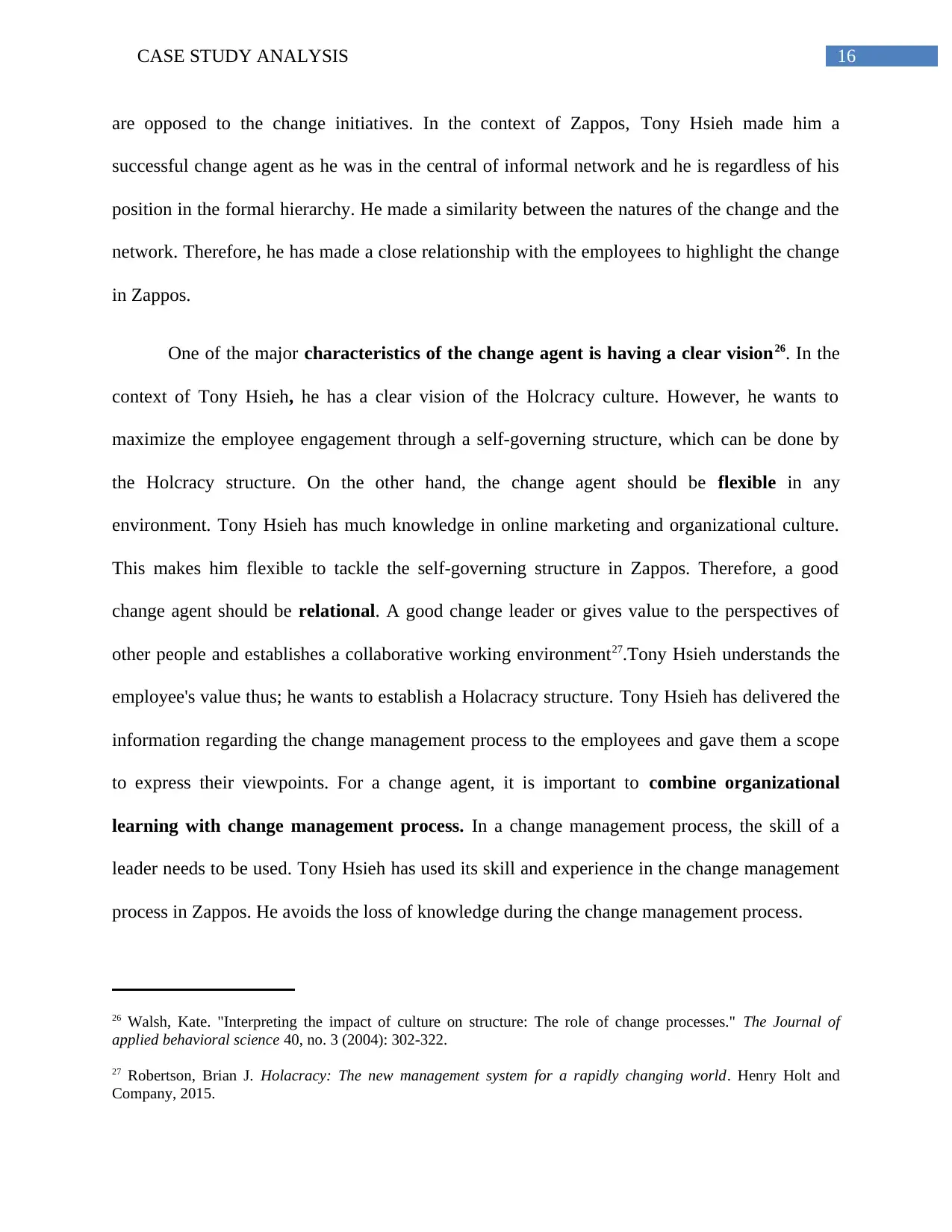
16CASE STUDY ANALYSIS
are opposed to the change initiatives. In the context of Zappos, Tony Hsieh made him a
successful change agent as he was in the central of informal network and he is regardless of his
position in the formal hierarchy. He made a similarity between the natures of the change and the
network. Therefore, he has made a close relationship with the employees to highlight the change
in Zappos.
One of the major characteristics of the change agent is having a clear vision26. In the
context of Tony Hsieh, he has a clear vision of the Holcracy culture. However, he wants to
maximize the employee engagement through a self-governing structure, which can be done by
the Holcracy structure. On the other hand, the change agent should be flexible in any
environment. Tony Hsieh has much knowledge in online marketing and organizational culture.
This makes him flexible to tackle the self-governing structure in Zappos. Therefore, a good
change agent should be relational. A good change leader or gives value to the perspectives of
other people and establishes a collaborative working environment27.Tony Hsieh understands the
employee's value thus; he wants to establish a Holacracy structure. Tony Hsieh has delivered the
information regarding the change management process to the employees and gave them a scope
to express their viewpoints. For a change agent, it is important to combine organizational
learning with change management process. In a change management process, the skill of a
leader needs to be used. Tony Hsieh has used its skill and experience in the change management
process in Zappos. He avoids the loss of knowledge during the change management process.
26 Walsh, Kate. "Interpreting the impact of culture on structure: The role of change processes." The Journal of
applied behavioral science 40, no. 3 (2004): 302-322.
27 Robertson, Brian J. Holacracy: The new management system for a rapidly changing world. Henry Holt and
Company, 2015.
are opposed to the change initiatives. In the context of Zappos, Tony Hsieh made him a
successful change agent as he was in the central of informal network and he is regardless of his
position in the formal hierarchy. He made a similarity between the natures of the change and the
network. Therefore, he has made a close relationship with the employees to highlight the change
in Zappos.
One of the major characteristics of the change agent is having a clear vision26. In the
context of Tony Hsieh, he has a clear vision of the Holcracy culture. However, he wants to
maximize the employee engagement through a self-governing structure, which can be done by
the Holcracy structure. On the other hand, the change agent should be flexible in any
environment. Tony Hsieh has much knowledge in online marketing and organizational culture.
This makes him flexible to tackle the self-governing structure in Zappos. Therefore, a good
change agent should be relational. A good change leader or gives value to the perspectives of
other people and establishes a collaborative working environment27.Tony Hsieh understands the
employee's value thus; he wants to establish a Holacracy structure. Tony Hsieh has delivered the
information regarding the change management process to the employees and gave them a scope
to express their viewpoints. For a change agent, it is important to combine organizational
learning with change management process. In a change management process, the skill of a
leader needs to be used. Tony Hsieh has used its skill and experience in the change management
process in Zappos. He avoids the loss of knowledge during the change management process.
26 Walsh, Kate. "Interpreting the impact of culture on structure: The role of change processes." The Journal of
applied behavioral science 40, no. 3 (2004): 302-322.
27 Robertson, Brian J. Holacracy: The new management system for a rapidly changing world. Henry Holt and
Company, 2015.
Secure Best Marks with AI Grader
Need help grading? Try our AI Grader for instant feedback on your assignments.
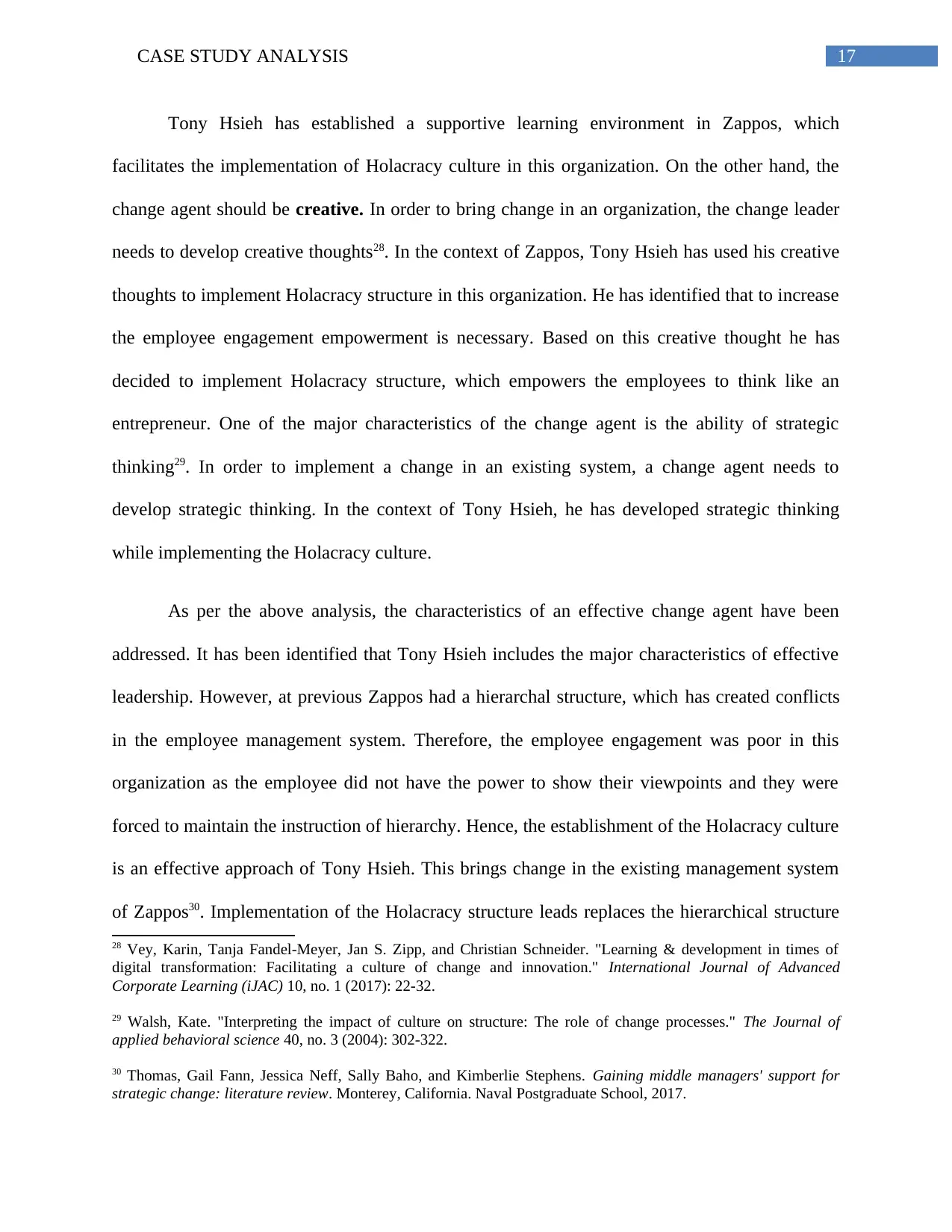
17CASE STUDY ANALYSIS
Tony Hsieh has established a supportive learning environment in Zappos, which
facilitates the implementation of Holacracy culture in this organization. On the other hand, the
change agent should be creative. In order to bring change in an organization, the change leader
needs to develop creative thoughts28. In the context of Zappos, Tony Hsieh has used his creative
thoughts to implement Holacracy structure in this organization. He has identified that to increase
the employee engagement empowerment is necessary. Based on this creative thought he has
decided to implement Holacracy structure, which empowers the employees to think like an
entrepreneur. One of the major characteristics of the change agent is the ability of strategic
thinking29. In order to implement a change in an existing system, a change agent needs to
develop strategic thinking. In the context of Tony Hsieh, he has developed strategic thinking
while implementing the Holacracy culture.
As per the above analysis, the characteristics of an effective change agent have been
addressed. It has been identified that Tony Hsieh includes the major characteristics of effective
leadership. However, at previous Zappos had a hierarchal structure, which has created conflicts
in the employee management system. Therefore, the employee engagement was poor in this
organization as the employee did not have the power to show their viewpoints and they were
forced to maintain the instruction of hierarchy. Hence, the establishment of the Holacracy culture
is an effective approach of Tony Hsieh. This brings change in the existing management system
of Zappos30. Implementation of the Holacracy structure leads replaces the hierarchical structure
28 Vey, Karin, Tanja Fandel-Meyer, Jan S. Zipp, and Christian Schneider. "Learning & development in times of
digital transformation: Facilitating a culture of change and innovation." International Journal of Advanced
Corporate Learning (iJAC) 10, no. 1 (2017): 22-32.
29 Walsh, Kate. "Interpreting the impact of culture on structure: The role of change processes." The Journal of
applied behavioral science 40, no. 3 (2004): 302-322.
30 Thomas, Gail Fann, Jessica Neff, Sally Baho, and Kimberlie Stephens. Gaining middle managers' support for
strategic change: literature review. Monterey, California. Naval Postgraduate School, 2017.
Tony Hsieh has established a supportive learning environment in Zappos, which
facilitates the implementation of Holacracy culture in this organization. On the other hand, the
change agent should be creative. In order to bring change in an organization, the change leader
needs to develop creative thoughts28. In the context of Zappos, Tony Hsieh has used his creative
thoughts to implement Holacracy structure in this organization. He has identified that to increase
the employee engagement empowerment is necessary. Based on this creative thought he has
decided to implement Holacracy structure, which empowers the employees to think like an
entrepreneur. One of the major characteristics of the change agent is the ability of strategic
thinking29. In order to implement a change in an existing system, a change agent needs to
develop strategic thinking. In the context of Tony Hsieh, he has developed strategic thinking
while implementing the Holacracy culture.
As per the above analysis, the characteristics of an effective change agent have been
addressed. It has been identified that Tony Hsieh includes the major characteristics of effective
leadership. However, at previous Zappos had a hierarchal structure, which has created conflicts
in the employee management system. Therefore, the employee engagement was poor in this
organization as the employee did not have the power to show their viewpoints and they were
forced to maintain the instruction of hierarchy. Hence, the establishment of the Holacracy culture
is an effective approach of Tony Hsieh. This brings change in the existing management system
of Zappos30. Implementation of the Holacracy structure leads replaces the hierarchical structure
28 Vey, Karin, Tanja Fandel-Meyer, Jan S. Zipp, and Christian Schneider. "Learning & development in times of
digital transformation: Facilitating a culture of change and innovation." International Journal of Advanced
Corporate Learning (iJAC) 10, no. 1 (2017): 22-32.
29 Walsh, Kate. "Interpreting the impact of culture on structure: The role of change processes." The Journal of
applied behavioral science 40, no. 3 (2004): 302-322.
30 Thomas, Gail Fann, Jessica Neff, Sally Baho, and Kimberlie Stephens. Gaining middle managers' support for
strategic change: literature review. Monterey, California. Naval Postgraduate School, 2017.
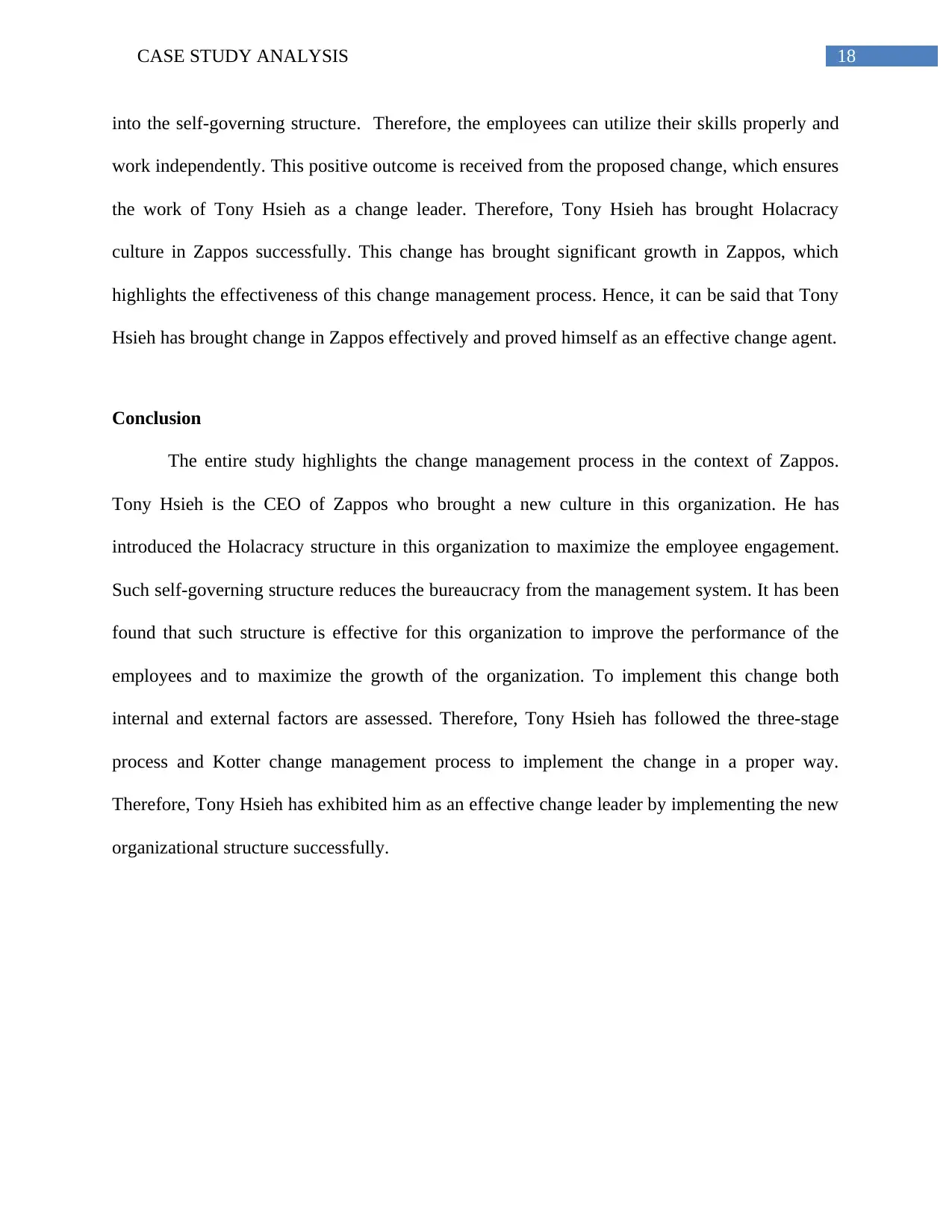
18CASE STUDY ANALYSIS
into the self-governing structure. Therefore, the employees can utilize their skills properly and
work independently. This positive outcome is received from the proposed change, which ensures
the work of Tony Hsieh as a change leader. Therefore, Tony Hsieh has brought Holacracy
culture in Zappos successfully. This change has brought significant growth in Zappos, which
highlights the effectiveness of this change management process. Hence, it can be said that Tony
Hsieh has brought change in Zappos effectively and proved himself as an effective change agent.
Conclusion
The entire study highlights the change management process in the context of Zappos.
Tony Hsieh is the CEO of Zappos who brought a new culture in this organization. He has
introduced the Holacracy structure in this organization to maximize the employee engagement.
Such self-governing structure reduces the bureaucracy from the management system. It has been
found that such structure is effective for this organization to improve the performance of the
employees and to maximize the growth of the organization. To implement this change both
internal and external factors are assessed. Therefore, Tony Hsieh has followed the three-stage
process and Kotter change management process to implement the change in a proper way.
Therefore, Tony Hsieh has exhibited him as an effective change leader by implementing the new
organizational structure successfully.
into the self-governing structure. Therefore, the employees can utilize their skills properly and
work independently. This positive outcome is received from the proposed change, which ensures
the work of Tony Hsieh as a change leader. Therefore, Tony Hsieh has brought Holacracy
culture in Zappos successfully. This change has brought significant growth in Zappos, which
highlights the effectiveness of this change management process. Hence, it can be said that Tony
Hsieh has brought change in Zappos effectively and proved himself as an effective change agent.
Conclusion
The entire study highlights the change management process in the context of Zappos.
Tony Hsieh is the CEO of Zappos who brought a new culture in this organization. He has
introduced the Holacracy structure in this organization to maximize the employee engagement.
Such self-governing structure reduces the bureaucracy from the management system. It has been
found that such structure is effective for this organization to improve the performance of the
employees and to maximize the growth of the organization. To implement this change both
internal and external factors are assessed. Therefore, Tony Hsieh has followed the three-stage
process and Kotter change management process to implement the change in a proper way.
Therefore, Tony Hsieh has exhibited him as an effective change leader by implementing the new
organizational structure successfully.
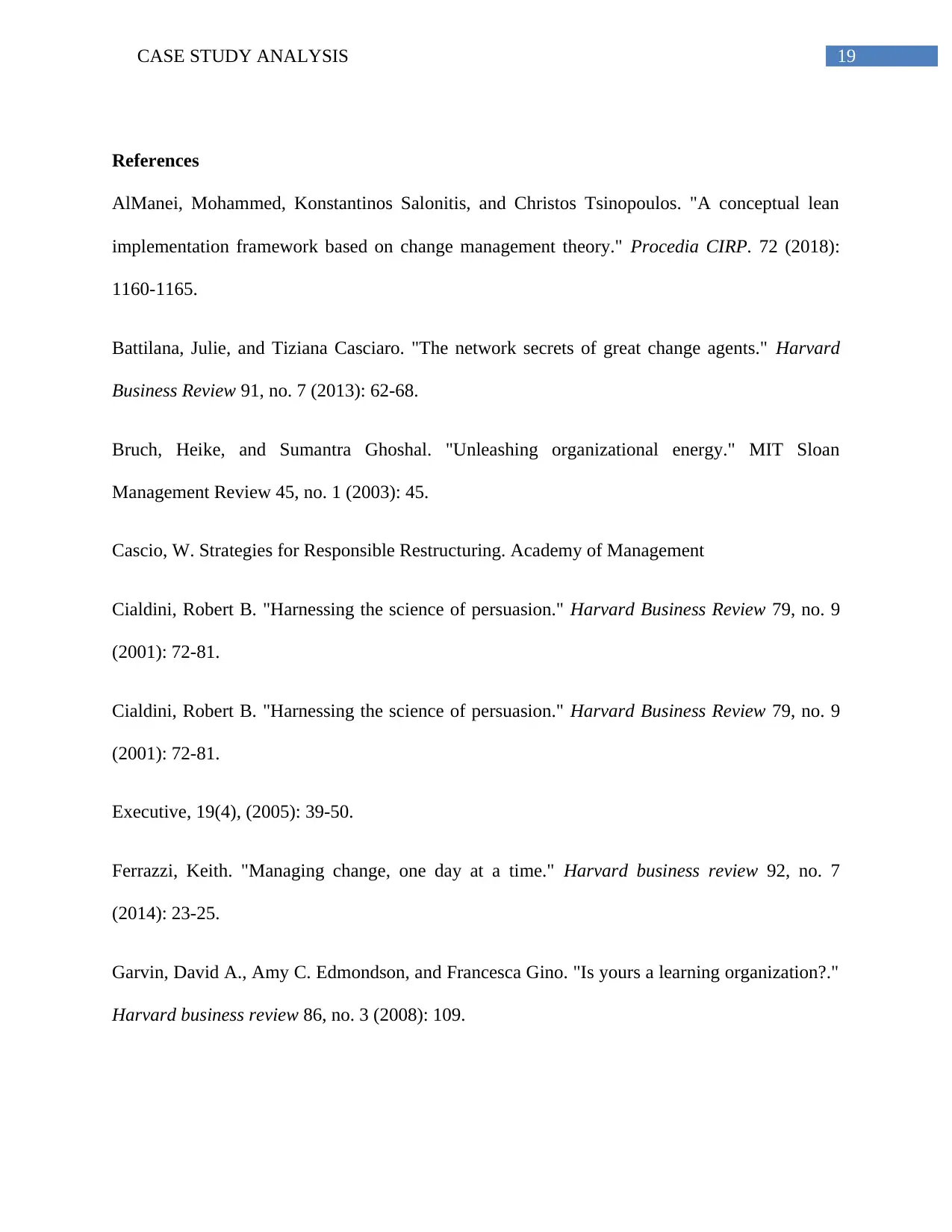
19CASE STUDY ANALYSIS
References
AlManei, Mohammed, Konstantinos Salonitis, and Christos Tsinopoulos. "A conceptual lean
implementation framework based on change management theory." Procedia CIRP. 72 (2018):
1160-1165.
Battilana, Julie, and Tiziana Casciaro. "The network secrets of great change agents." Harvard
Business Review 91, no. 7 (2013): 62-68.
Bruch, Heike, and Sumantra Ghoshal. "Unleashing organizational energy." MIT Sloan
Management Review 45, no. 1 (2003): 45.
Cascio, W. Strategies for Responsible Restructuring. Academy of Management
Cialdini, Robert B. "Harnessing the science of persuasion." Harvard Business Review 79, no. 9
(2001): 72-81.
Cialdini, Robert B. "Harnessing the science of persuasion." Harvard Business Review 79, no. 9
(2001): 72-81.
Executive, 19(4), (2005): 39‐50.
Ferrazzi, Keith. "Managing change, one day at a time." Harvard business review 92, no. 7
(2014): 23-25.
Garvin, David A., Amy C. Edmondson, and Francesca Gino. "Is yours a learning organization?."
Harvard business review 86, no. 3 (2008): 109.
References
AlManei, Mohammed, Konstantinos Salonitis, and Christos Tsinopoulos. "A conceptual lean
implementation framework based on change management theory." Procedia CIRP. 72 (2018):
1160-1165.
Battilana, Julie, and Tiziana Casciaro. "The network secrets of great change agents." Harvard
Business Review 91, no. 7 (2013): 62-68.
Bruch, Heike, and Sumantra Ghoshal. "Unleashing organizational energy." MIT Sloan
Management Review 45, no. 1 (2003): 45.
Cascio, W. Strategies for Responsible Restructuring. Academy of Management
Cialdini, Robert B. "Harnessing the science of persuasion." Harvard Business Review 79, no. 9
(2001): 72-81.
Cialdini, Robert B. "Harnessing the science of persuasion." Harvard Business Review 79, no. 9
(2001): 72-81.
Executive, 19(4), (2005): 39‐50.
Ferrazzi, Keith. "Managing change, one day at a time." Harvard business review 92, no. 7
(2014): 23-25.
Garvin, David A., Amy C. Edmondson, and Francesca Gino. "Is yours a learning organization?."
Harvard business review 86, no. 3 (2008): 109.
Paraphrase This Document
Need a fresh take? Get an instant paraphrase of this document with our AI Paraphraser
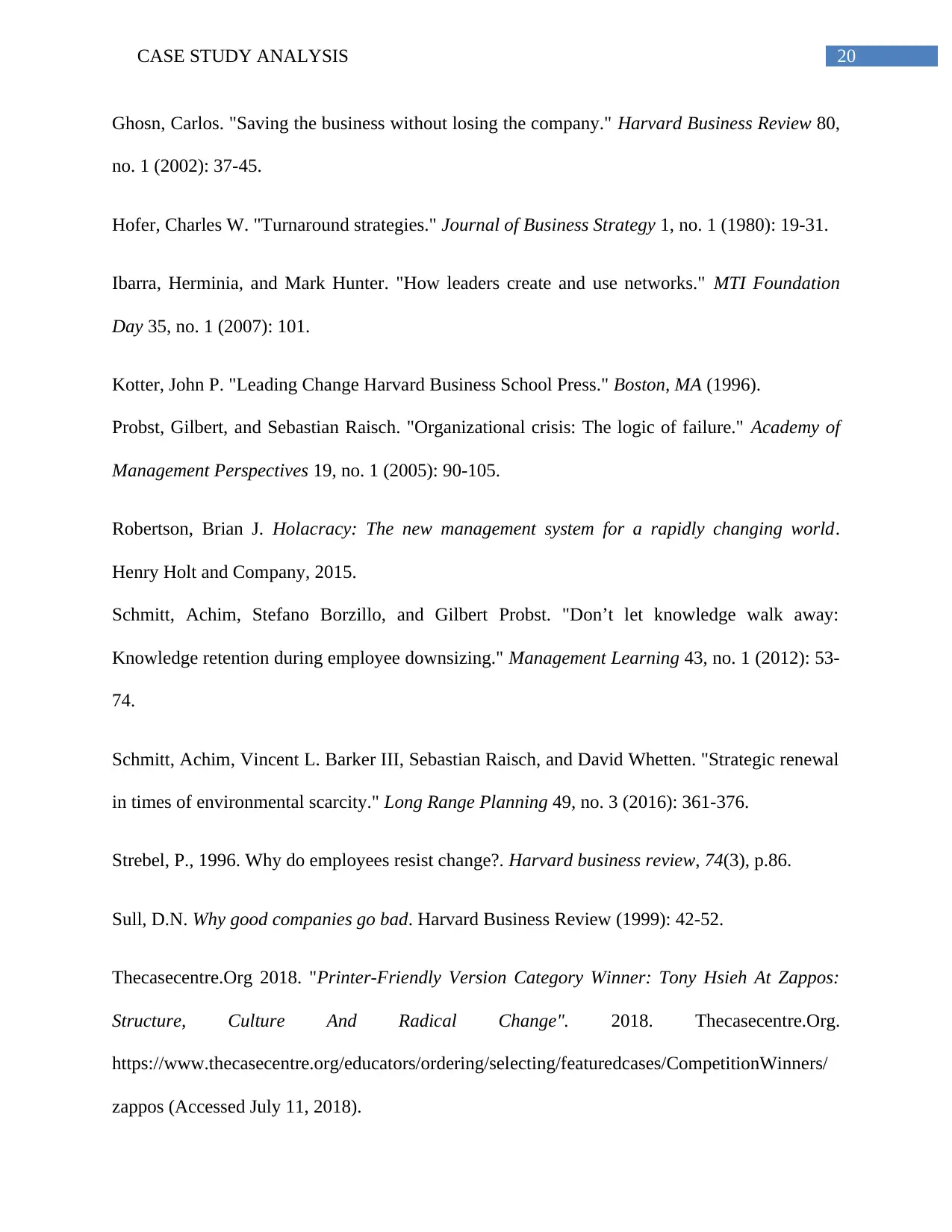
20CASE STUDY ANALYSIS
Ghosn, Carlos. "Saving the business without losing the company." Harvard Business Review 80,
no. 1 (2002): 37-45.
Hofer, Charles W. "Turnaround strategies." Journal of Business Strategy 1, no. 1 (1980): 19-31.
Ibarra, Herminia, and Mark Hunter. "How leaders create and use networks." MTI Foundation
Day 35, no. 1 (2007): 101.
Kotter, John P. "Leading Change Harvard Business School Press." Boston, MA (1996).
Probst, Gilbert, and Sebastian Raisch. "Organizational crisis: The logic of failure." Academy of
Management Perspectives 19, no. 1 (2005): 90-105.
Robertson, Brian J. Holacracy: The new management system for a rapidly changing world.
Henry Holt and Company, 2015.
Schmitt, Achim, Stefano Borzillo, and Gilbert Probst. "Don’t let knowledge walk away:
Knowledge retention during employee downsizing." Management Learning 43, no. 1 (2012): 53-
74.
Schmitt, Achim, Vincent L. Barker III, Sebastian Raisch, and David Whetten. "Strategic renewal
in times of environmental scarcity." Long Range Planning 49, no. 3 (2016): 361-376.
Strebel, P., 1996. Why do employees resist change?. Harvard business review, 74(3), p.86.
Sull, D.N. Why good companies go bad. Harvard Business Review (1999): 42‐52.
Thecasecentre.Org 2018. "Printer-Friendly Version Category Winner: Tony Hsieh At Zappos:
Structure, Culture And Radical Change". 2018. Thecasecentre.Org.
https://www.thecasecentre.org/educators/ordering/selecting/featuredcases/CompetitionWinners/
zappos (Accessed July 11, 2018).
Ghosn, Carlos. "Saving the business without losing the company." Harvard Business Review 80,
no. 1 (2002): 37-45.
Hofer, Charles W. "Turnaround strategies." Journal of Business Strategy 1, no. 1 (1980): 19-31.
Ibarra, Herminia, and Mark Hunter. "How leaders create and use networks." MTI Foundation
Day 35, no. 1 (2007): 101.
Kotter, John P. "Leading Change Harvard Business School Press." Boston, MA (1996).
Probst, Gilbert, and Sebastian Raisch. "Organizational crisis: The logic of failure." Academy of
Management Perspectives 19, no. 1 (2005): 90-105.
Robertson, Brian J. Holacracy: The new management system for a rapidly changing world.
Henry Holt and Company, 2015.
Schmitt, Achim, Stefano Borzillo, and Gilbert Probst. "Don’t let knowledge walk away:
Knowledge retention during employee downsizing." Management Learning 43, no. 1 (2012): 53-
74.
Schmitt, Achim, Vincent L. Barker III, Sebastian Raisch, and David Whetten. "Strategic renewal
in times of environmental scarcity." Long Range Planning 49, no. 3 (2016): 361-376.
Strebel, P., 1996. Why do employees resist change?. Harvard business review, 74(3), p.86.
Sull, D.N. Why good companies go bad. Harvard Business Review (1999): 42‐52.
Thecasecentre.Org 2018. "Printer-Friendly Version Category Winner: Tony Hsieh At Zappos:
Structure, Culture And Radical Change". 2018. Thecasecentre.Org.
https://www.thecasecentre.org/educators/ordering/selecting/featuredcases/CompetitionWinners/
zappos (Accessed July 11, 2018).
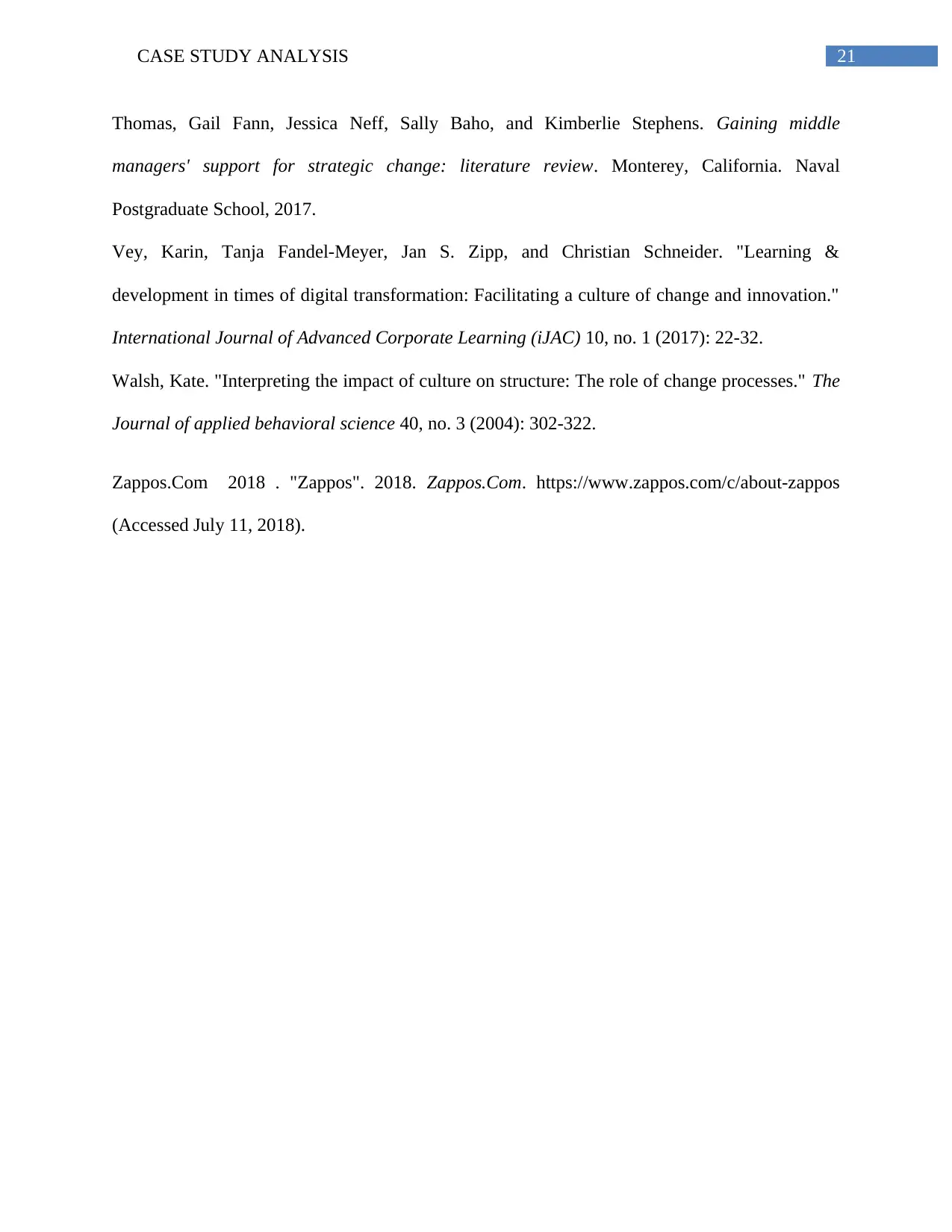
21CASE STUDY ANALYSIS
Thomas, Gail Fann, Jessica Neff, Sally Baho, and Kimberlie Stephens. Gaining middle
managers' support for strategic change: literature review. Monterey, California. Naval
Postgraduate School, 2017.
Vey, Karin, Tanja Fandel-Meyer, Jan S. Zipp, and Christian Schneider. "Learning &
development in times of digital transformation: Facilitating a culture of change and innovation."
International Journal of Advanced Corporate Learning (iJAC) 10, no. 1 (2017): 22-32.
Walsh, Kate. "Interpreting the impact of culture on structure: The role of change processes." The
Journal of applied behavioral science 40, no. 3 (2004): 302-322.
Zappos.Com 2018 . "Zappos". 2018. Zappos.Com. https://www.zappos.com/c/about-zappos
(Accessed July 11, 2018).
Thomas, Gail Fann, Jessica Neff, Sally Baho, and Kimberlie Stephens. Gaining middle
managers' support for strategic change: literature review. Monterey, California. Naval
Postgraduate School, 2017.
Vey, Karin, Tanja Fandel-Meyer, Jan S. Zipp, and Christian Schneider. "Learning &
development in times of digital transformation: Facilitating a culture of change and innovation."
International Journal of Advanced Corporate Learning (iJAC) 10, no. 1 (2017): 22-32.
Walsh, Kate. "Interpreting the impact of culture on structure: The role of change processes." The
Journal of applied behavioral science 40, no. 3 (2004): 302-322.
Zappos.Com 2018 . "Zappos". 2018. Zappos.Com. https://www.zappos.com/c/about-zappos
(Accessed July 11, 2018).
1 out of 21
Related Documents
Your All-in-One AI-Powered Toolkit for Academic Success.
+13062052269
info@desklib.com
Available 24*7 on WhatsApp / Email
![[object Object]](/_next/static/media/star-bottom.7253800d.svg)
Unlock your academic potential
© 2024 | Zucol Services PVT LTD | All rights reserved.





